A Visit to the High End 2022 show in Munich - Part III
Reporter: Carlo Iaccarino
The show took place from May, 19th through May, 22th, 2022 at the M.O.C. facilities, in Munich, Germany
Originally written: May, 2022
Website with plenty of resources: High End Society
Re-Start
Here we have another example of the trend to stuff loudspeakers with all you need to play your music, preferably from a non-physical source.
At the SVS booth, I enjoyed their usually spectacular multichannel audio/video demonstration. Yet, what most attracted me was the Prime Wireless Pro Speaker, whose price at the time of the show was tbd, but projected around Eur 1.200/pair.
A quick glance would tell you it is a normal 2-way bookshelf. But a more attentive examination reveals, at its front panel's base, knobs and pushbuttons that make you think of an amplified loudspeaker.
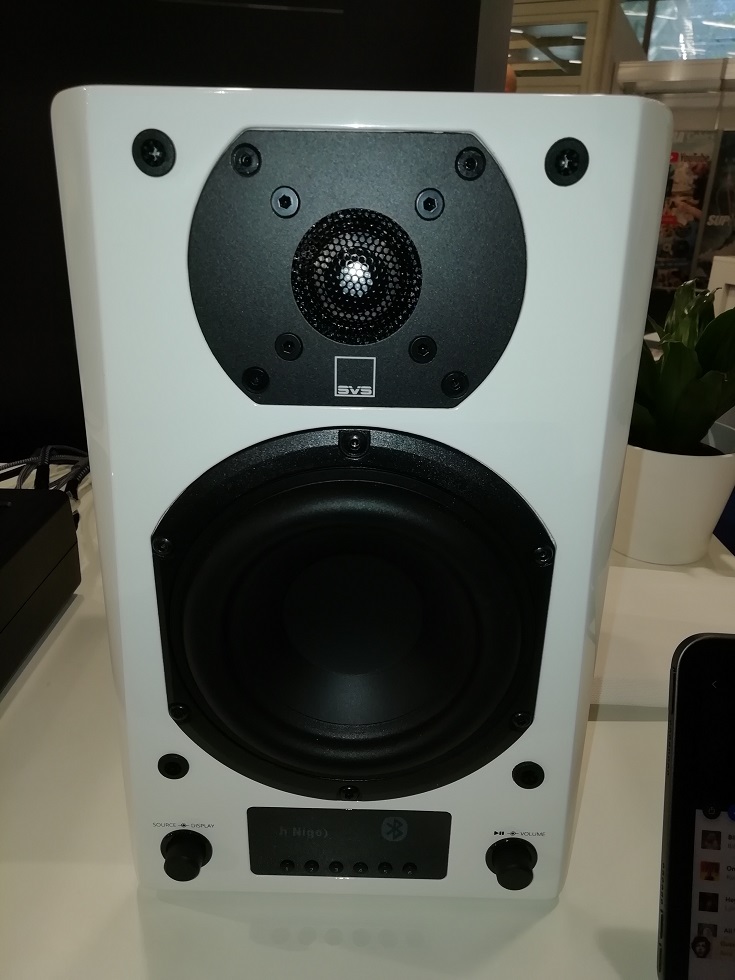
As sometimes happens, you retrieve better details looking at the B-side:-)
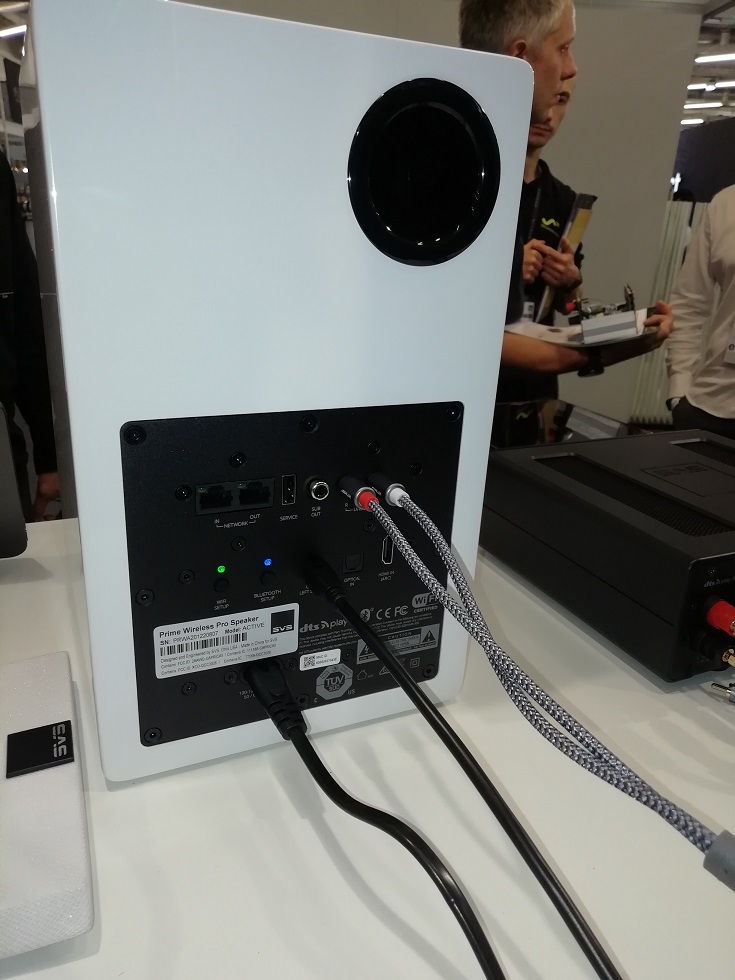
Then you understand that this loudspeaker is not just amplified, but connected. All the connections are on the main speaker, the right one, connected to the other one with a cable. This system can connect to a LAN either via Ethernet or via WiFi. Aerial connections include Bluetooth. As you see, there's also a line output for driving a subwoofer (SVS' workhorse). You also find an interesting HDMI ARC input, for a quick and bi-directional connection with your flat panel TV (I guess also with a vpj, a TV/SAT decoder, a Blu-Ray player, etc. - I forgot to ask, but I can't see why it shouldn't be so). There is also an optical digital input, to connect less updated video screens or other digital sources that have that same kind of output (that should be intrinsically free from unwanted signal coming in from the ground paths). Lastly, there is a line input. This loudspeaker uses DSP for x-over duties. It can process Hi-Res digital signals up to 192 kHz / 24 bits. It is controlled with SVS' own app, and its streamer abilities include Chromecast and Spotify Connect. On its front panel's base you find a display, too, small but useful to know which input is on, which preset you selected, etc.
I can't tell you how they sound - they were exposed on a shelf, almost distractly placed there. I don't think it was a sloppy presentation; rather, they wanted to show how easy they could be placed around the house. It seemed to me that SVS' idea was to provide an alternative to the ubiquitous soundbars, with which they compete, pricewise; yet, for me they can make for a nice "first system", ready also to obey to the vinyl fad, by connecting to their line input one of the many turntables now available with an internal pre-phono.
Another example of an all-in-one loudspeaker I'd like to point you at is the one made by the Danish comnpany System Audio, their SA air 1 model.
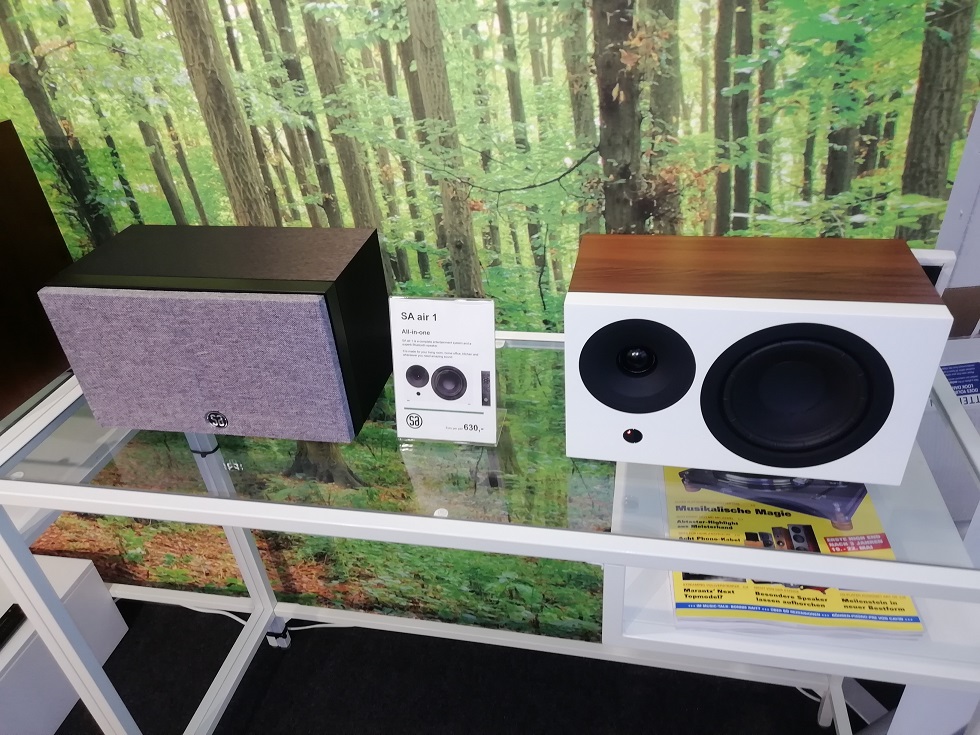
Here we have another compact, 2-way, amplified bookshelf loudspeaker; DSP X-over, propietary drivers, 2 digital optical inputs, 2 analogue inputs, 1 subwoofer line output, HDMI ARC input, Bluetooth input. Its features seem to mimic those of the SVS'model. Unlike it, the Air 1 doesn't have streaming abilities, but it has a phono preamp inside. Moreover, instead of the utilitarian aestethics of the SVS model, this compact SA model displays the clean lines of its Scandinavian look; this, in my opinion, makes it a much better fit for a domestic environment, especially for rooms whose interiors consist of the famous furnitures you assemble on your own... For me, this loudspeaker's main value lies in it being appropriate not for the usual, gray, middle-aged, well-heeled audiophile, but, rather, for a more diverse group of customers, likely made up of young people, probably with limited budget. I arrived at this conclusion by considering this loudspeaker's technical features, that clearly envision, as a source for the audio signal, your video screen, or your cell phone. But also by considering its aesthetics, and the company's own ads, which say it is made for your living room, home office, kitchen..., never mentioning anything like as a music room. And, not least, by considering its price, of only Eur 680/pair (about half as the Prime's price). I can't tell you how it sounds, because it was only on static display.
A different approach to the integration of several functions into a single device comes from a big name in consumer electronics, Yamaha, whose exhibition was of the "just add speakers" type (in this case, the speakers were the NS-2000 floorstanders, whose price should be between Eur 3.500 and 4.000).
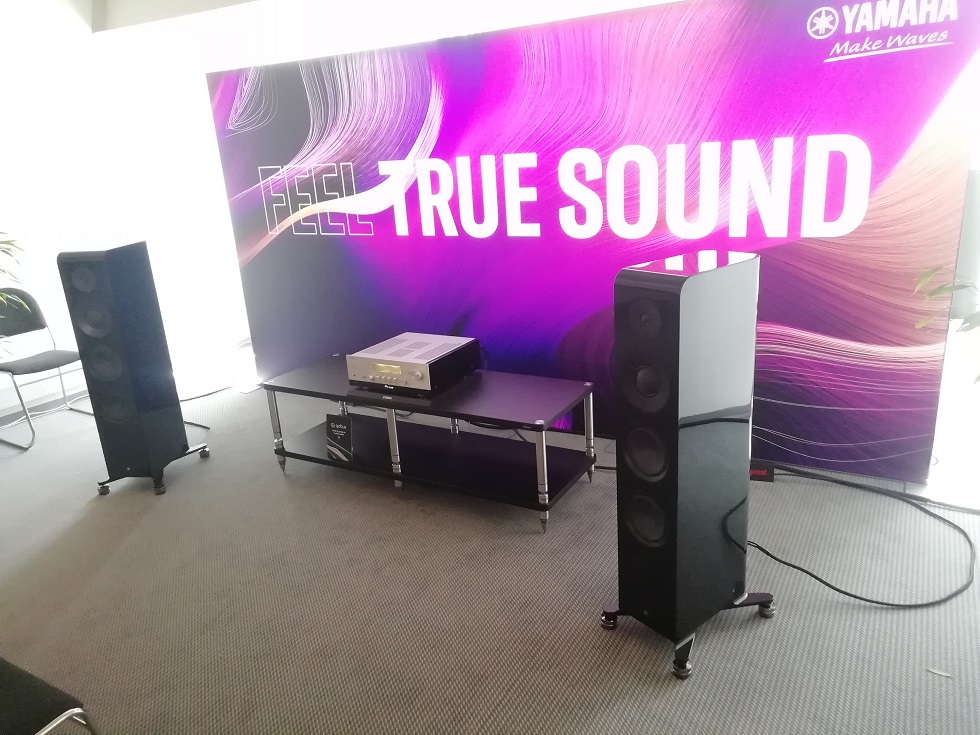
It is their R-N2000A amplifier, for about Eur 4.000.
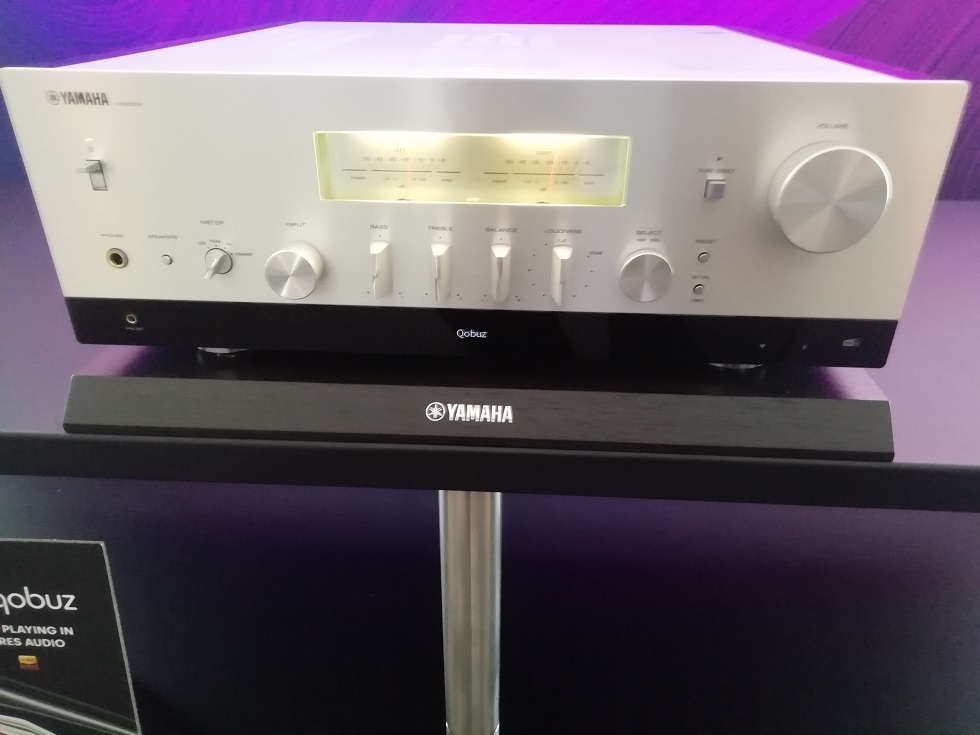
Yamaha calls it a Network receiver. It is a stereo integrated amplifier that has a DAC and a streamer inside. You can connect it to your PC or your LAN and have access to your music files, be they on a resource in your network or on the servers of your music provider - Yamaha specifies compatiblity with Qobuz, Tidal, Spotify, Amazon, etc. Everything is controlled by the unavoidable app, in this case the true-and-tested MusicCast, that allows you to direct the musical stream also towards other devices connectred on the same LAN, provided they feature the same interface.
Yamaha is clearly aiming at us old farts with this device, whose look is decidedly traditional - the amplifier is a perfect lookalike of the classic integrated amplfiers by the 3-diapason brand; it even has the wooden side panels... To be aware of its second millenium functionalities, you must look at the narrow strip on the bottom of the front panel (where, not casually, the headphone output is placed), which hosts a little display giving informations about the selected source and the track playing, and that, when turned off, was barely noticeable, at least to this glasses wearer.
Rose, too, followed the "just add speakers" trend, but with a much more updated approach, wanting to depart from the traditional schemes.
Among the wide range of this company's products, I'd like to highlight you their RS 201 model. It is a complete and powerful manager of digital signals in high resolution (and also hi-def video in 4K...); it sports a power amplifier, albeit modest (2 x 50 W, and specified at 4 Ohm). Its inputs accept everything. It's Roon-ready; it's compatible with practically all music providers; it can connect to a LAN with either Ethernet or WiFi; it obviously has Bluetooth connectivity. It allows you to rip your CDs onto its internal HD (or in other network resoruces). It decodes PCM and DSD natively... Summing up, a very powerful digital machine. Its expected price should be about Eur 2.200.
Here we have it, flanked by the optional external CD drive. On the left you can see also the RS 250 model, which sports similar specifications (slightly better: it decodes up to DSD 512 and contains an ESS 9838Q2M Chip DAC), but without the power amplifier section. With an expected price of Eur 2.500.
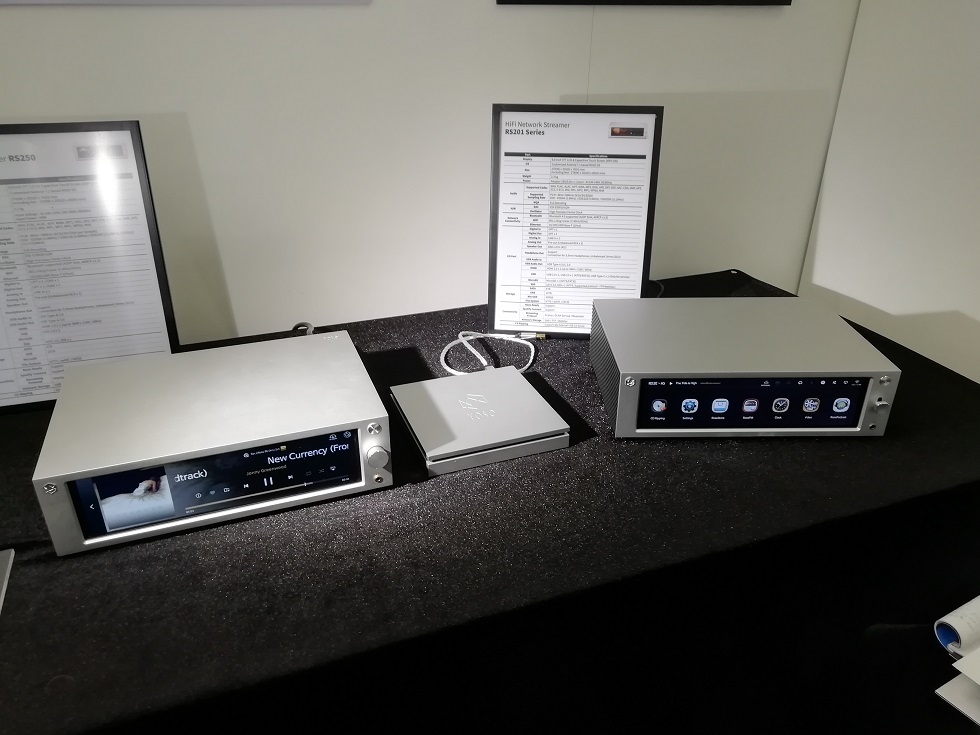
As you see, the look of these devices has nothing in common with classic Hi-Fi shapes, except for the boxiness. Everything is controlled by touching the wide and easily readable front panel or, you bet, with their propietary app.
Here we have an eloquent picture of the physical connections you can find on the 201's rear panel.
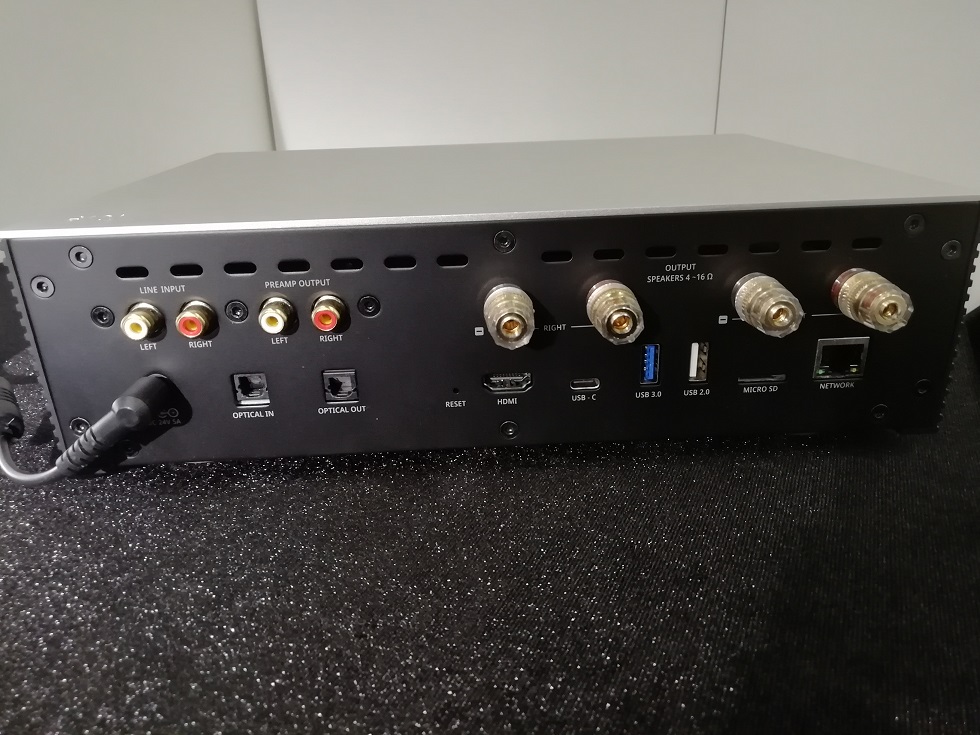
It is a complete device and, in my opinion, its ability to also play the A/V streams must be appreciated: this is another way to attract people outside the narrow audiophile tribe, and Rose does it while keeping relevant the quality of the audio signal processing; so, they can reassure audiophiles who might decide to follow the new ways of audiovisual domestic entertainment.
Strange & Curious
Also taking part in the show were presenters who produced items designed to solve very specific problems or following unconventional thinking.
An example comes from the Italian AngelAudio.
The company is headed by Mr. Paolo Agostinelli, an engineer who developed - and patented - two technologies. People from that company tried to educate me, but they can't do miracles, so you must make do with what my poor scientific background allowed me to understand. Their first idea is to feed every section of the electronics (so, also the signal that they process) with an energy which comes from light. Light is supposed to be immune from EMIs, whilst the normal circuits for transmitting electric energy (even the most high-performing ones) can't totally avoid them. This has led to the ALHENA technology.
The other idea is that you must in any case use physical connections to carry the signal processed by every device, either inside AngelAudio's gear or outside it, to make for the perfect interface with the rest of the world. This has led to the Bluwire technology.
Hence, the making of several devices. I indicate you three of them.
Here is the LAN-Rialto, for little more than Eur 3.000 (VAT excluded)
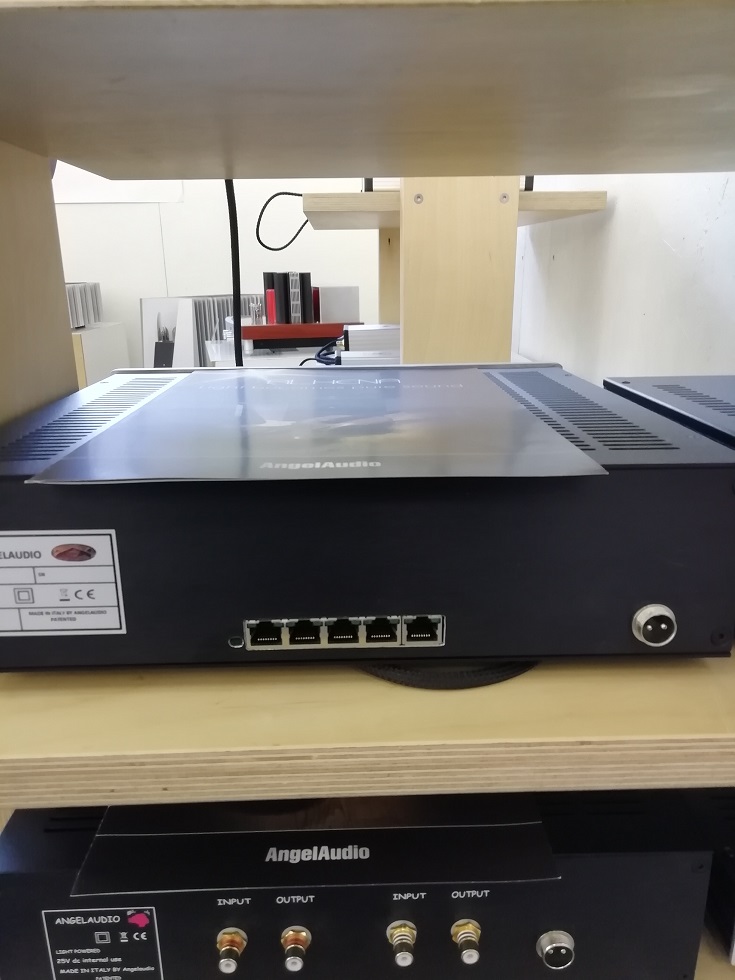
It really is what it looks like: a LAN switch, but made using the two technologies described above; moreover, it works also as a filter for the interferences between the peripherals connected to it.
This is the USB-Torcello, for about Eur 2.800 (VAT excluded), an Ethernet/USB interface; the connector on the right corner should put out (after a Bluwire-type circuit) the energy for powering your modem/router.
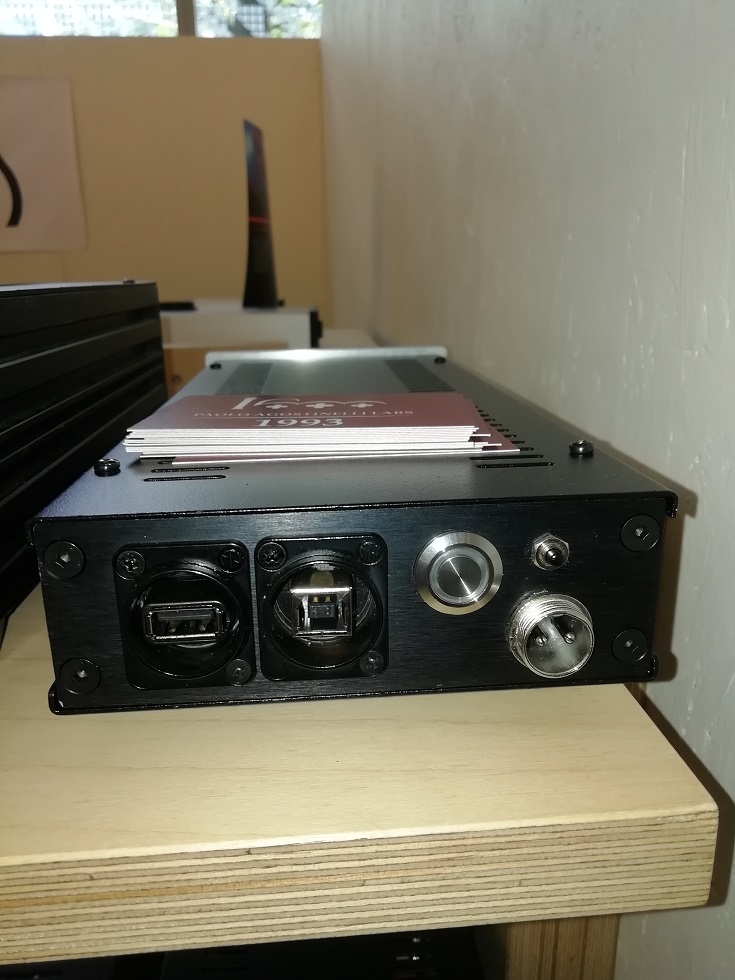
Then, here we have the PHONO PREAMP - Giudecca, for a little more than Eur 5.000 (VAT excluded), which looks like a more traditional pre phono,
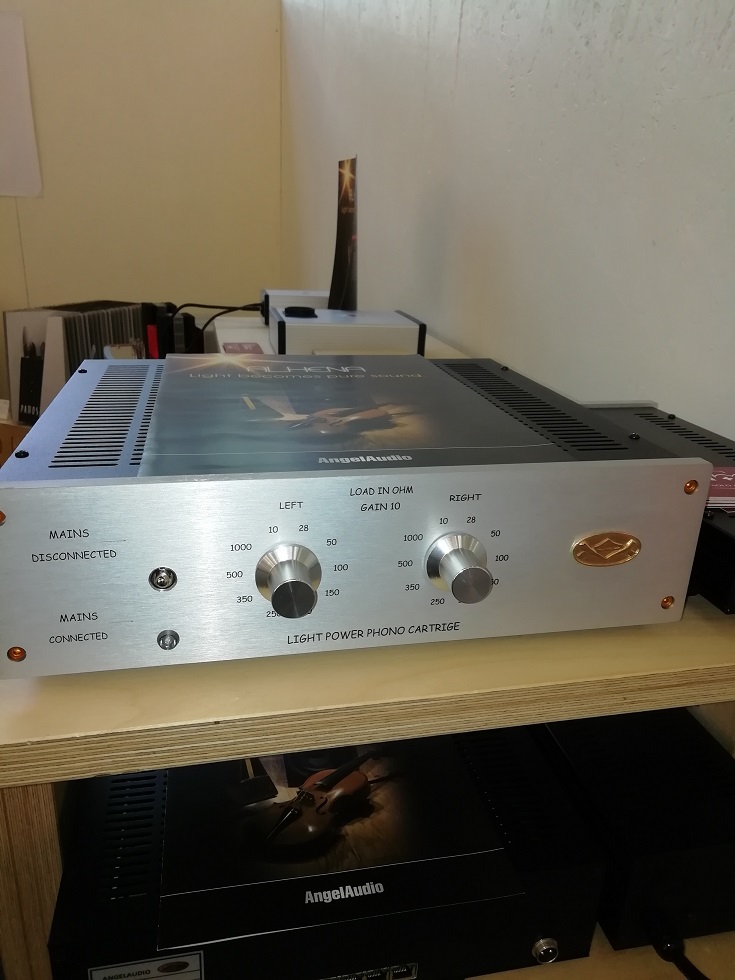
but that has very little of tradition. As you see, it can also work without a power supply and, anyway, the Alhena technolgy is used inside also to transmit the very weak signals coming from the cartridge. To be honest, I didn't understand if it works as a phono pre, or (or also...) as a filter to be put before your phono pre. As I wrote, this company's products are atypical, and my technical ignorance is wide. But I hope I have tickled your curiosity to know more about them ;-)
Nordost, too, exhibited, besides its usual range of cables and power accessories, a network switch for hi-Fi duties, the QNET, for Eur 3.000. It's little; it's round; it has 5 ports, of which 2 are limited to the 100BaseT speed, enough for audio
applications, to which Nordost applies their noise reduction techniques.
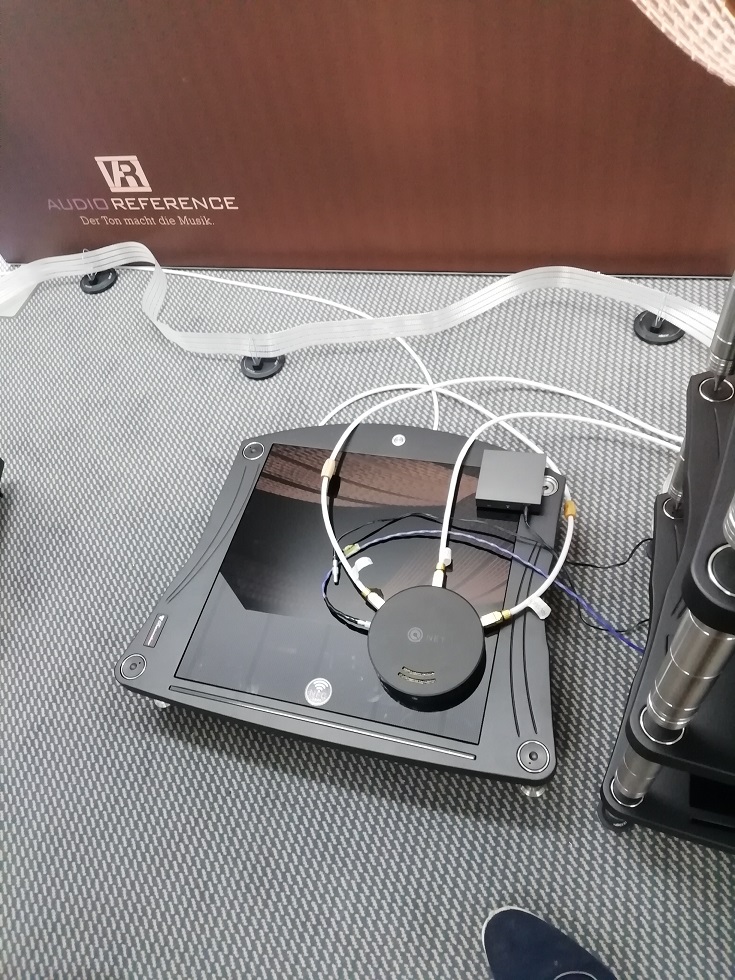
This switch comes with an external power supply, but obviously the company suggests you to power it via their dedicated accessories (of similar price...), and this was how it was installed in the exhibition system.
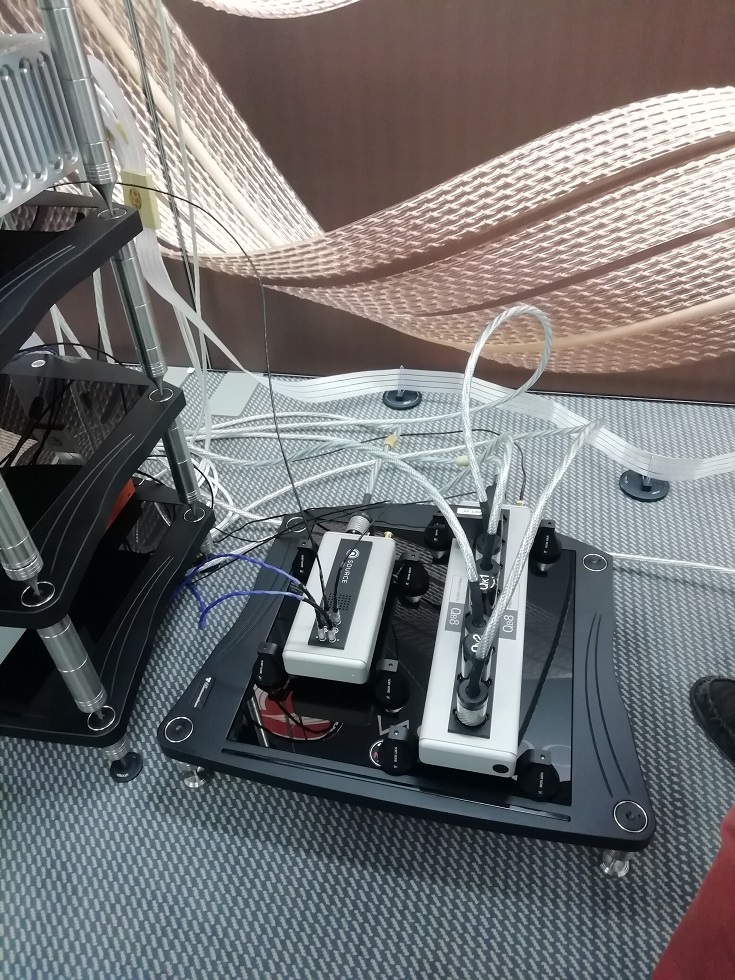
The Nordost demo was conducted following their usual modus operandi, that has proven successful in the past, of playing a system and then quickly changing in or out the single item under test (accessories, cable series, power filters, etc.).
Their demo was short and the room was a little space-constrained, yet I must say that switching from an ordinary network switch to the QNET made a difference; but I can't tell how much of the improved sound I heard was due to the fact that the QNET was powered by the special power supply and filter you see in my previous picture. I guess that, as usual, it all depends upon your own system's and mains' conditions. Sure, the MOC's grid is usually described as being not particularly high-performing, and it was bearing the load of all the demoed gear, and the interference from the wireless networks created by almost all the exhibitors - so those are conditions that I hope are much worse than the ones we encounter at home.
This year I seem to have noticed a bigger presence of acoustic treatments, and I had the chance to speak with several producers of panels and other devices for sound correction to be hung upon the wall, or to be otherwise placed in the room where you not only listen to the music but also normally carry out other domestic activities. I saw a general trend towards solutions that, while mainly aimed at effective acoustic treatment, allow for respecting the normal aesthetics of domestic environments - that is, not turning your living room into a recording studio.
Naturalacoustic is an Austrian company making panels and other elements - they use only natural elements, not artificial ones: wood, sheep wool, etc. For them is always easier to put into a home something that looks, and feel, organic, natural, alive, rather than artifical.
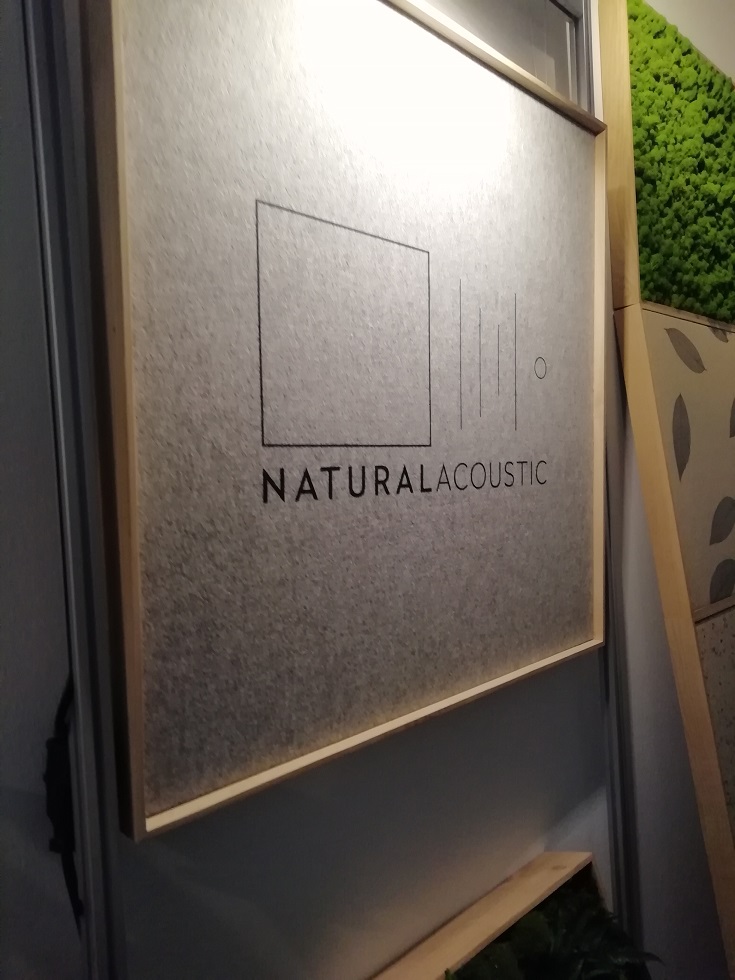
They provide a wide choice of materials, colours and shapes,
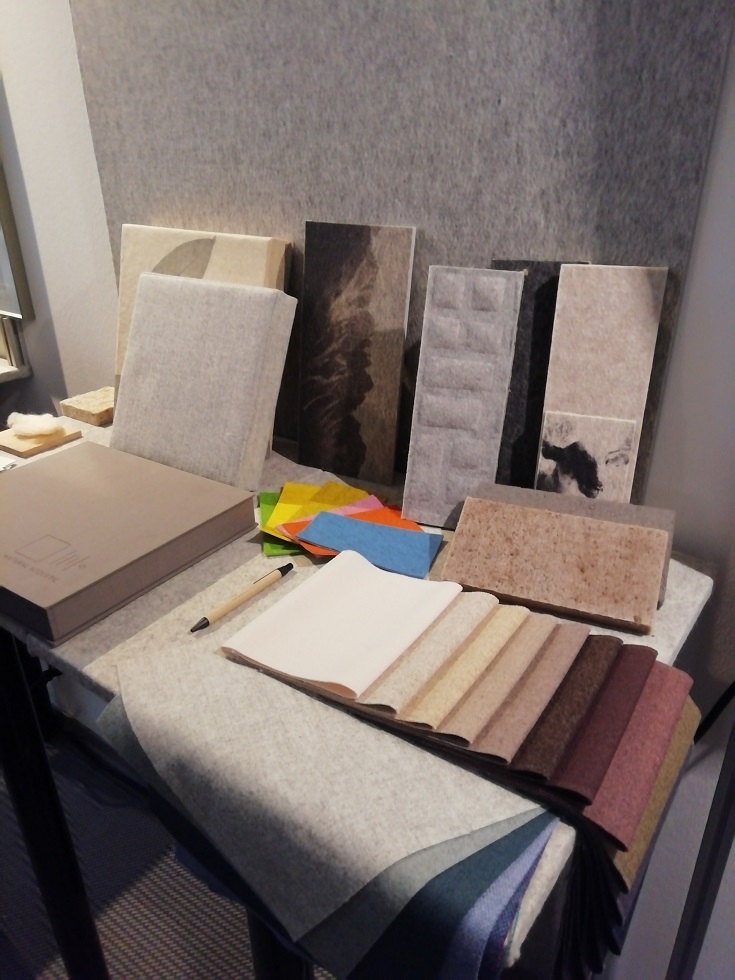
as well as the inner stuffing.
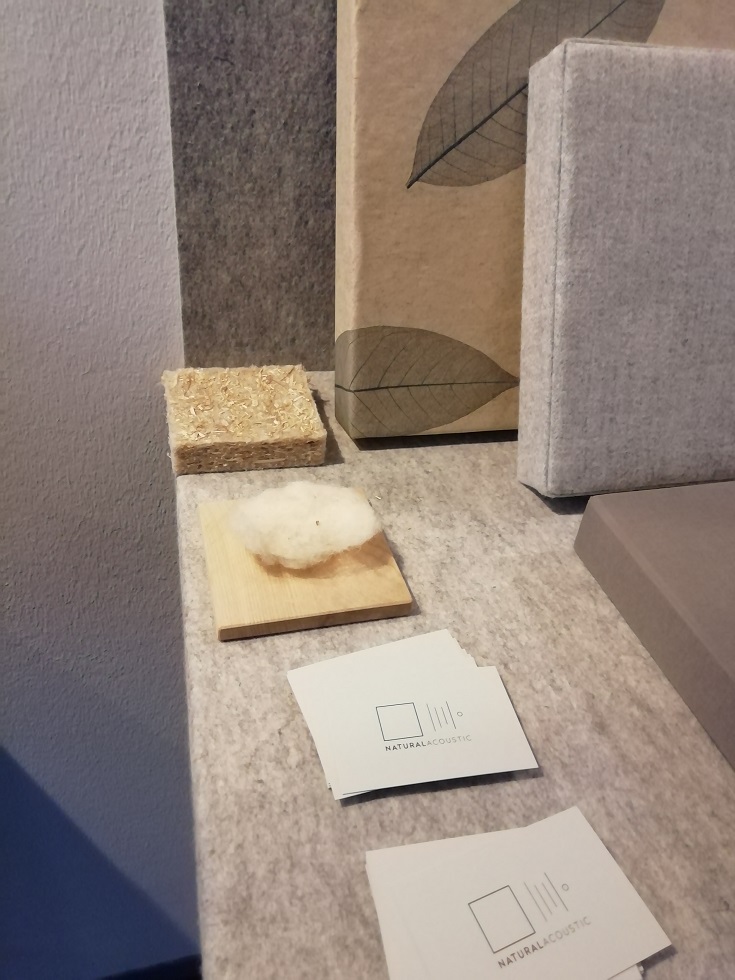
They design their treatments starting from their client's requests, and generally include a visit on-site. This is an Austrian company, based near Innsbruck, in Tyrol, and they said that it's not a problem for them to "come down" to Italy, meaning the Southern Tyrol, of course :-)
In TAD's room, too, you could find an imposing acoustic treatment.
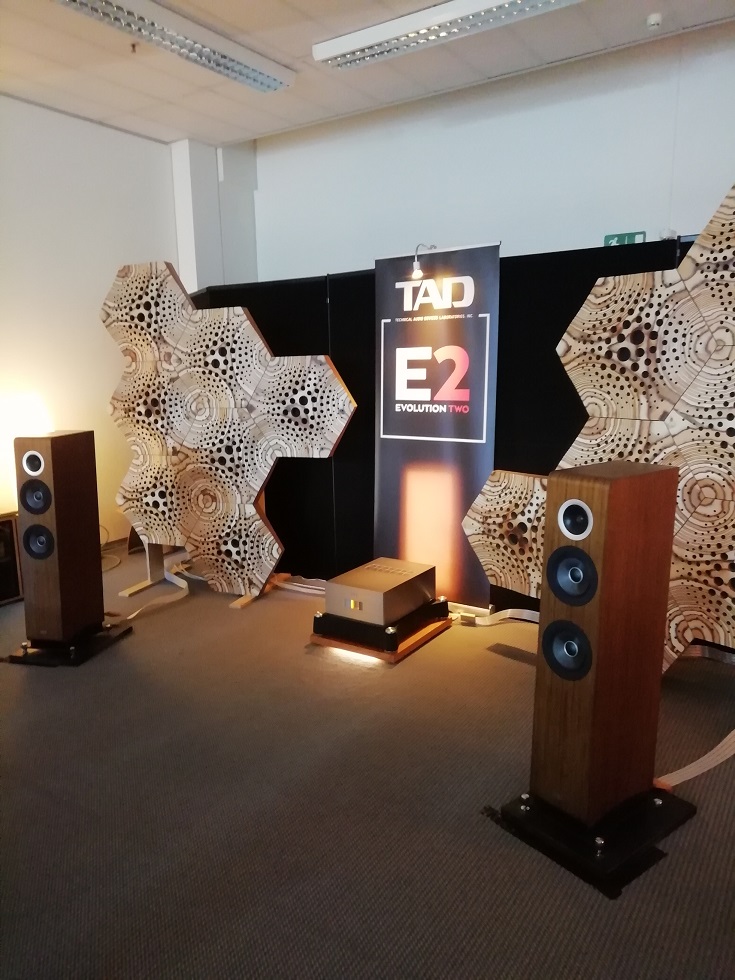
Panels were also placed along the side walls,
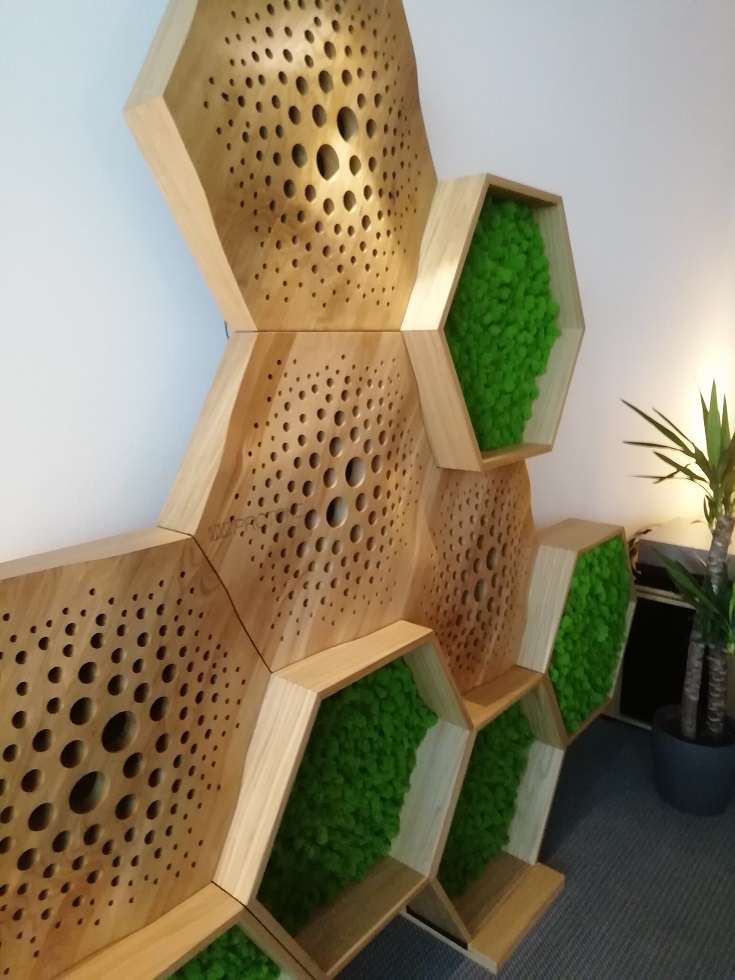
there were also panels that presented, besides cavities, a non-flat surface,
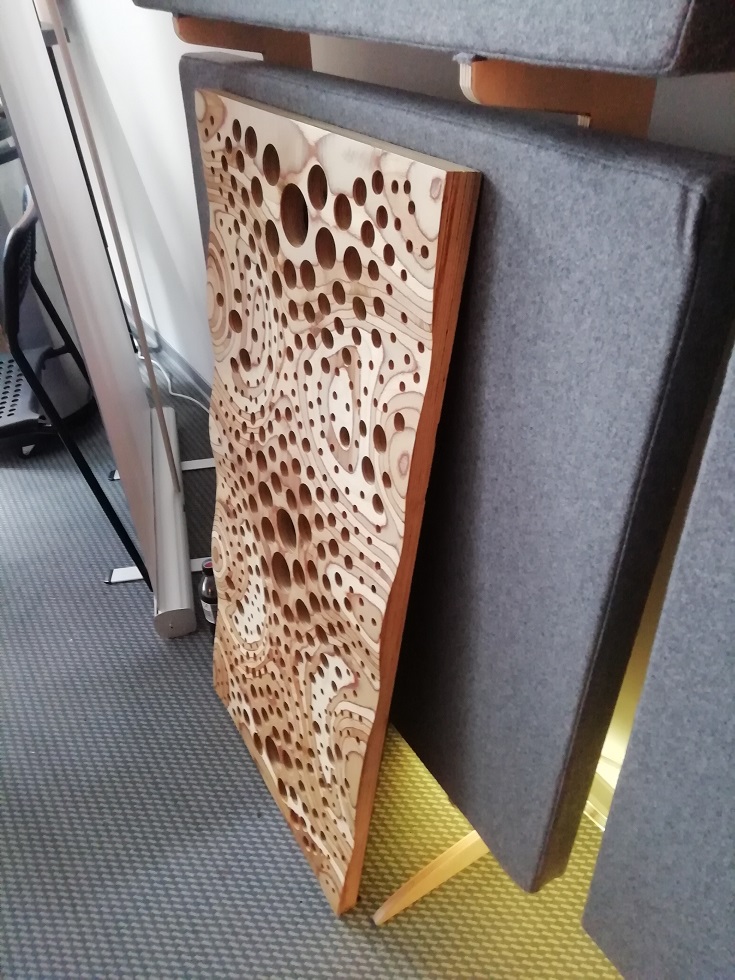
as well as panels that showed a sequence of spaces alternately empty and full.
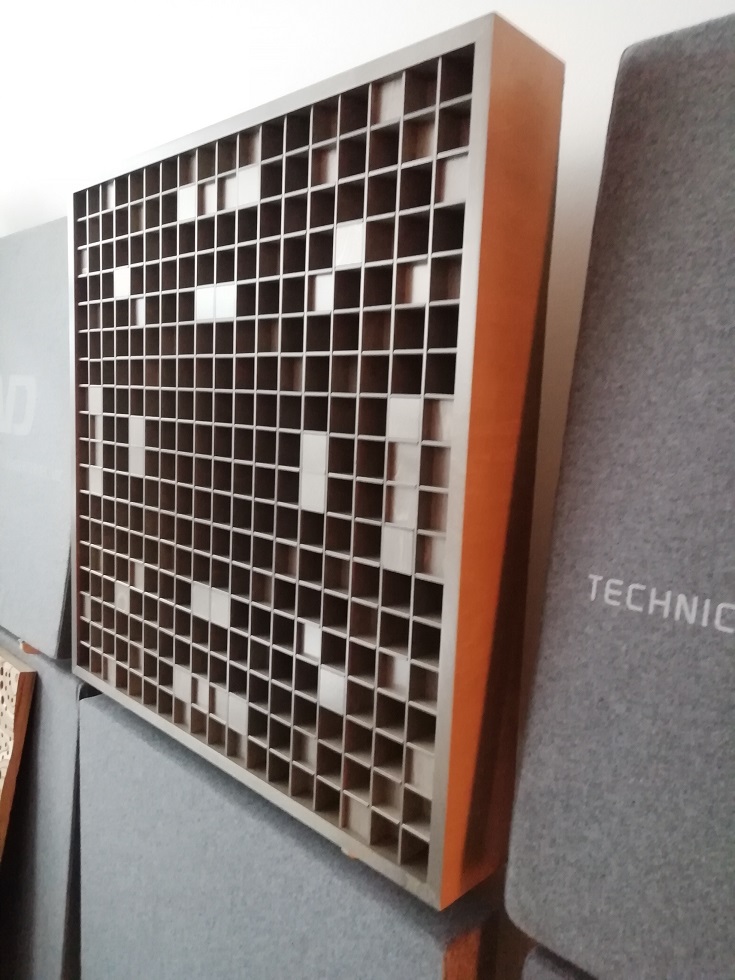
That room was actually set up to exhibit this brand's new loudspeakers, the Evolution 2s, for Eur 15.000.
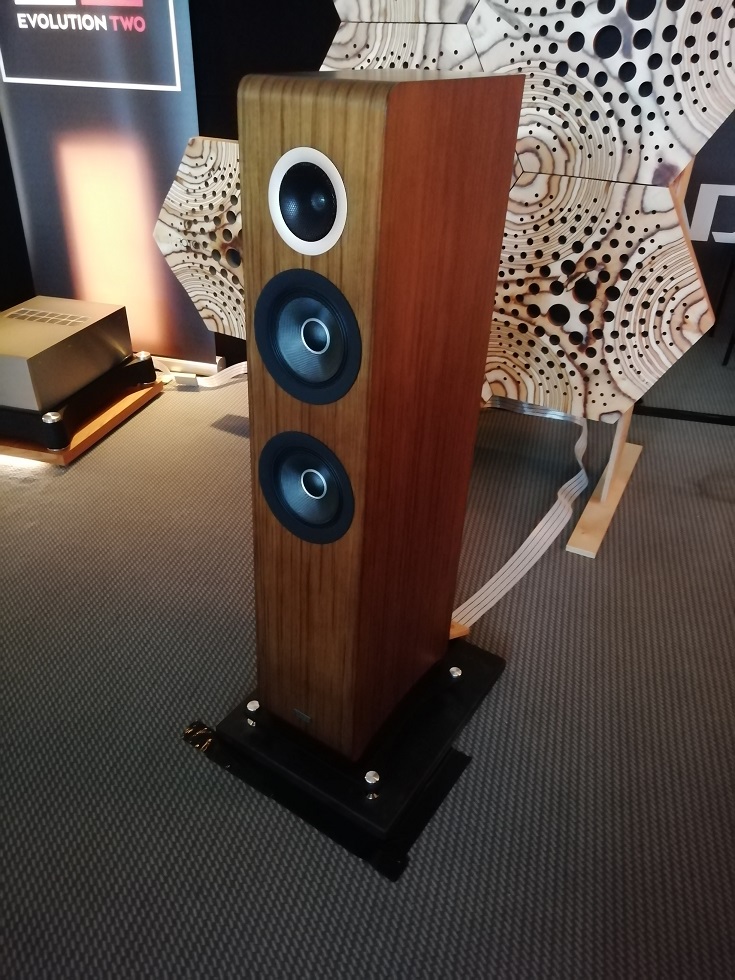
It's a floorstander, bass-reflex, two-way loudspeaker (the two woofers are crossed over at different frequencies), with a down-firing port that exhits from the front and rear sides of the base. In TAD's intention, it's a kind of "coming back" to their original models, to show that they can do a good, traditional loudspeaker, but with high-quality parts, like their recently developed driver. That's why for this loudspeaker they didn't use the - I'd say, now traditional, for TAD... - concentric mounting for midrange and tweeter, although at a first glace it may not seem so. Actually, the tweeter is mounted on its own, and it's surrounded by a purposedly designed waveguide.
If you have read my previous show reports, you probably remember that I always appreciated TAD's demos. So, I'm very sorry I have to say that this year I didn't like it as much as I used to. Of course, it's impossible to plea guilty for the new loudspeakers and release the amplifications (C-600 preamplifier and M700 S power amplifier, for a total of about Eur.100.000 ...) or the room, the latter still different from the ones occupied during last shows and, as you see, even treated
It's well known that the concentric mid/tw mounting distinguished the designs of Andrew Jones, the famous designer hired by the Pioneer/TAD group, who contributed to lots of successful loudspeaker models that sport just this particular solution - at unattainable prices fot TAD and at "human" prices for Pioneer. I remember that right in Munich, during the "Jones age", one year the demo was conducted using also the electronics by the "revived" brand Audio Alchemy, by Peter Madnick, another famous designer, who was also present at that show. Later, the German loudspeaker company Elac wanted to expand their operations, so they brought on board both Jones, joining the loudspeaker design team, and Madnick, for electronic gear. This led to very good loudspeakers and a very interesting range of electronics (initially named the Alchemy series...)
It's a recent (although not fresh) piece of news that Mr. Jones has been hired by the U.S. company Mobile Fidelity Sound Labs - MoFi, to their friends, that, hence forth, will add loudspeaker production to their original business of audiophile label and to their adjunctive business of making turntables, cartridges and phono preamplifiers.
What's curious, then? Well, in the wide MoFi room they exposed a new phono preamplifier by... Peter Madnick ;-)
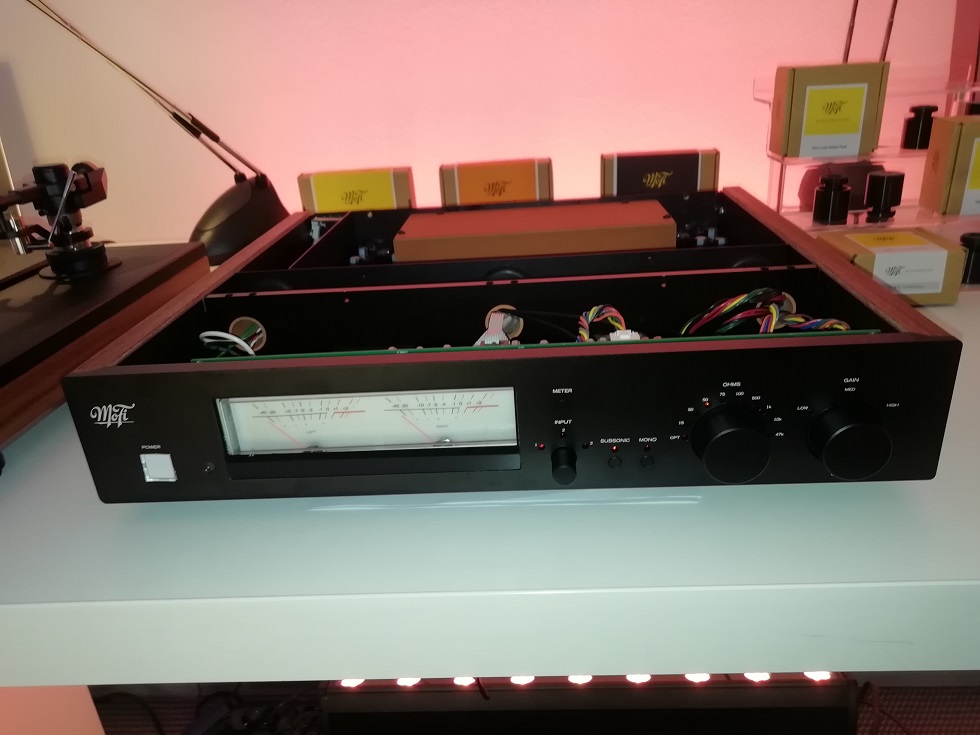
Here we have a voyeuristic look at its innards.
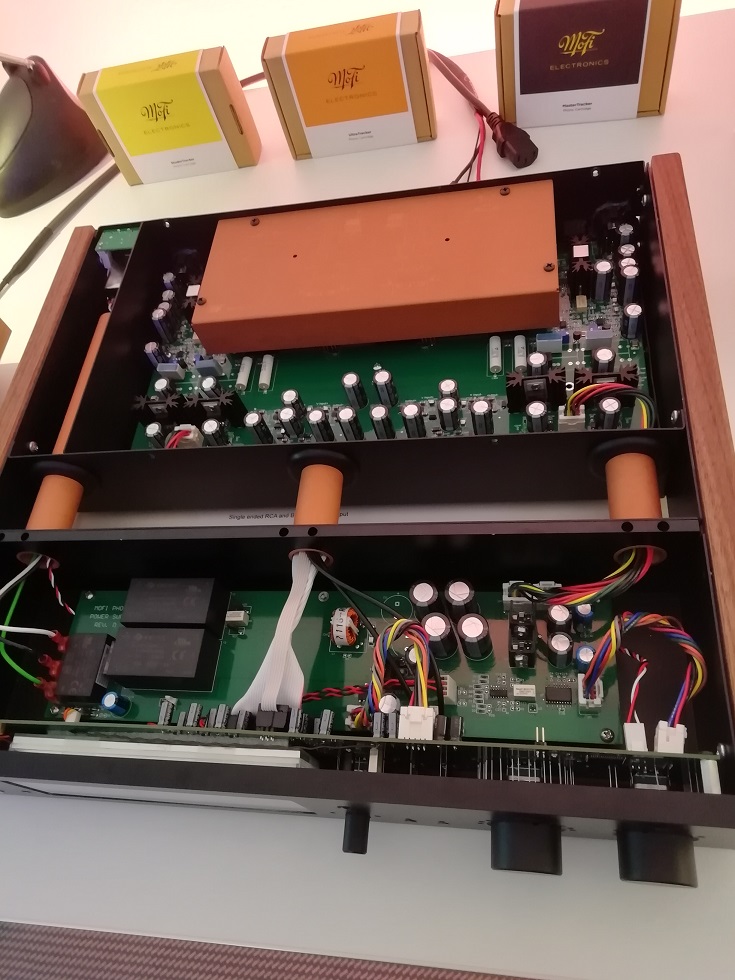
Of course, they also exhibited several turntables (for those, too, MoFi hired an expert, Allen Perkins, but I can't tell if he still works with them), so, keeping us in the curious land, I show you the beautiful Precision Deck, a turntable made with Fender, for a not unreachable price: less than Eur 4.000, Master Tracker cartridge included. It's a limited editon of 1.000, already sold-out (which means that some shops may still have some of the models they bought...), but they could make another batch.
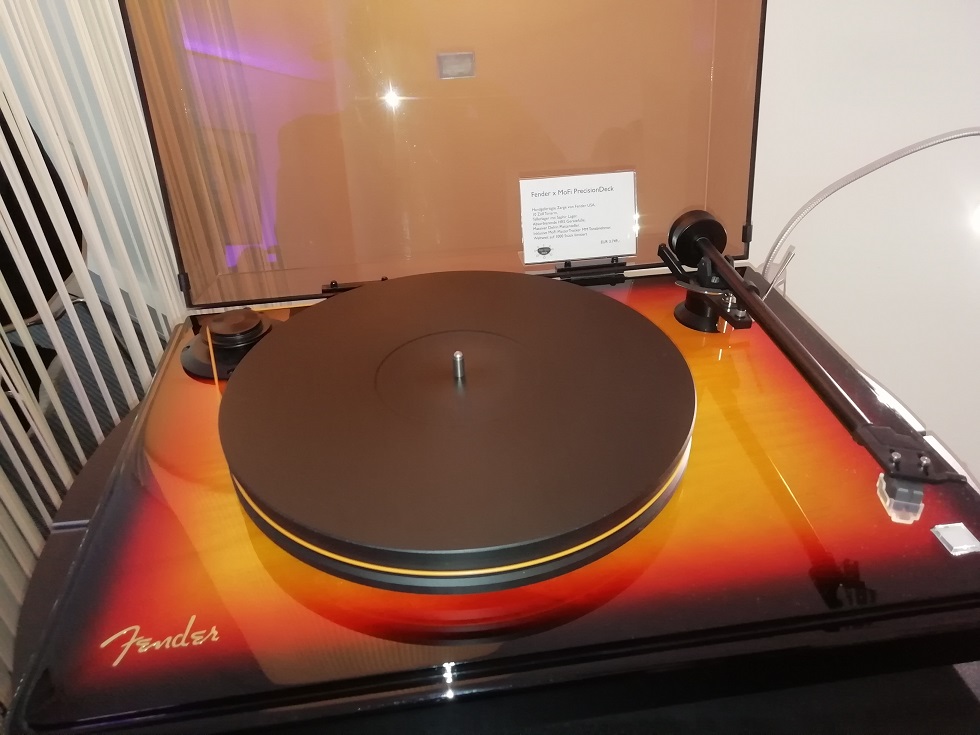
I already wrote that this year lots of celebrations were taking place, and also Monitor Audio celebrated something: their 50th anniversary.
For this occasion, they exhibited a flagship loudspeaker, the Concept 50 model, into which they poured all they know about materials and cabinet shape, and about driver building and configuration: I'd suggest a visit to their website, where you will find more and better information than mine.
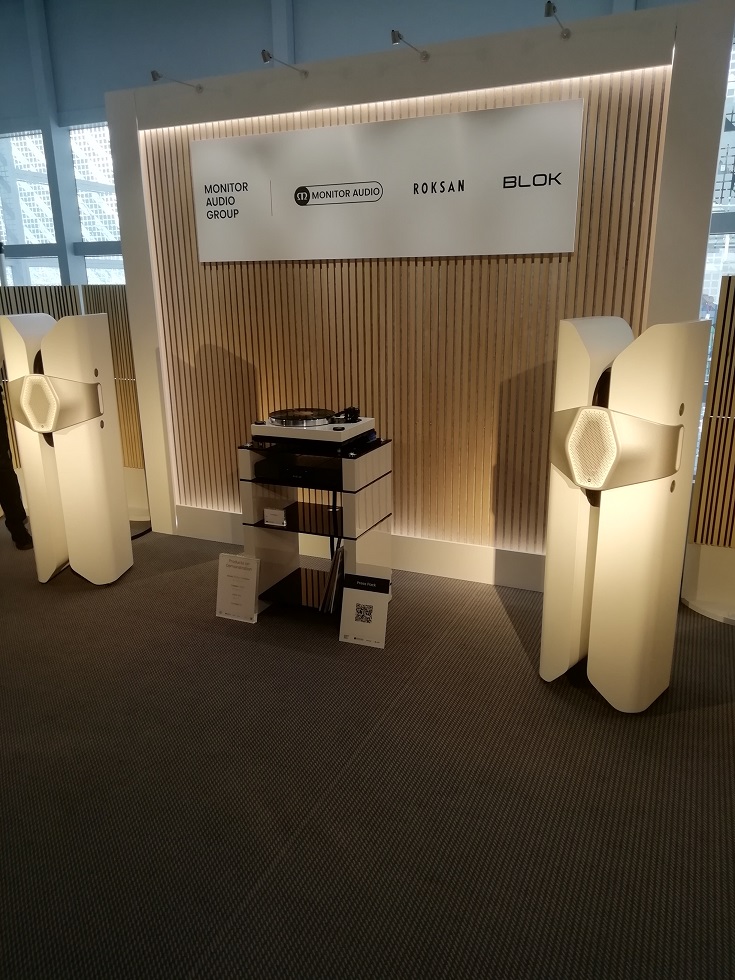
Price was still tbd, but they told me they think it will be availabe by the end of the year at a price of about UKP 50.000.
A(nother) flagship and celebratory loudspeaker, with plenty of technical solutions and research... Why am I putting it amongst the strange things?
Because, notwithstanding the emphasis M.A. placed on its aesthetics and design... Is it only to my eyes that they look like a giant clothespin? :-)
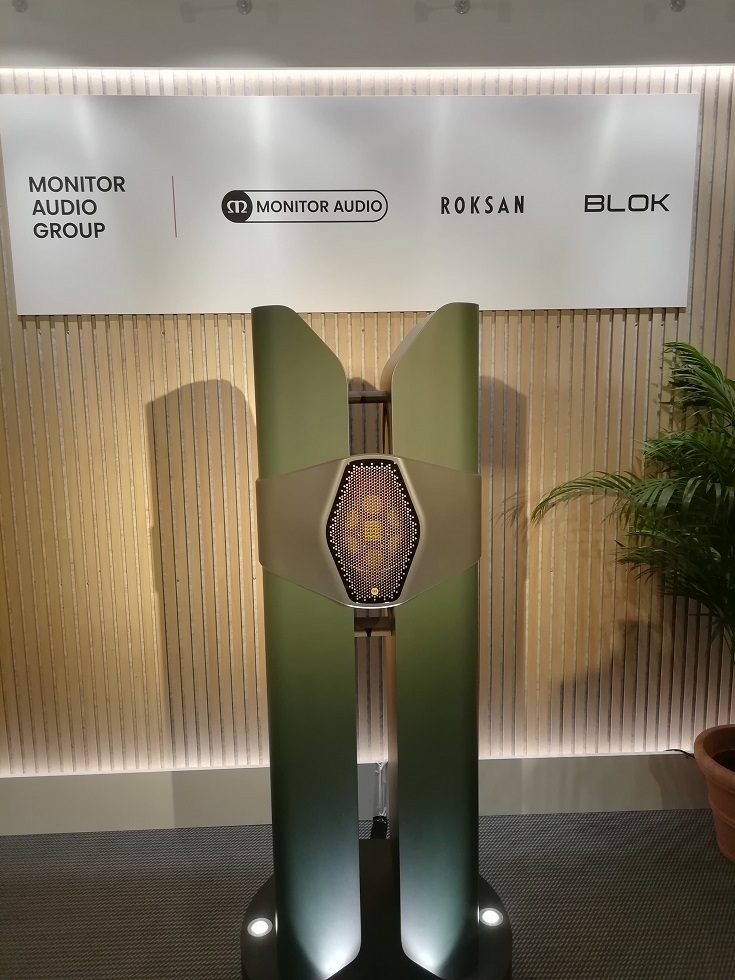
It's a joke, of course, and we wait to be able to listen to them in more appropriate rooms than the large and empty space in which they were shown.
As a final curiosity, I point you to the signal elaboration system BACCH-SP. It is a rare and interesting case of the pratical application of a theoretical study: software and an interface box are placed in the audio chain. They elaborate the audio signal before it is passed on to amplification and loudspeakers. BACCH-SP (SP stands for Stereo Purifier) is available either as a simple digital interface, to be inserted in your digtal chain before your DAC, for Eur 19.000; or as a box with its own DAC inside, that can be placed in your system just like any other analog source, for Eur 24.000.
The signal elaboration is intended to affect the "system" loudspeaker-room-listener, and enables the re-creation of a soundfield with realistic spatial characteristics. And without altering the timbral characteristic of the signal, something that may not always be guaranteed with other types of digital elaboration / DRC. It's a system that is strongly customized for the listener and their room position, thus their room provided a single chair exactly placed. I didn't have enough time to wait that the gentlemen preceeding me ended its righteous savouring of this technology, but I can assure you that even just standing behind that chair I could perceive a soundstage different from the ones usually re-created also in the best systems demoed; moreover, I could appreciate the "natural" sound diffusion. I am surely eager to know more about it, and I suggest you should be too. Should you need a better endorsement, I'll tell you that in the room also David Chesky was present - I guess he wanted to check the BACCH system with his new music productions under the The Audiophile Society moniker, dedicated to presenting a tridimensional soundfield whether listening through loudspeakers or through headphones.
That's all?
Obviously not. Exhibitors were many, and I'd like to show them all. But I must accept my poor photography skills, so I'll limit my report to the exhibitors that should not complain about how they are pictured ;-)
Also Technics celebrated an anniversary: the 50th birthday of the SL-1200 turntable, and, for the occasion, they produced the SL 1207ML model, a twelvethousand (actually, its base is its late reincarnation, the SL 1200 MK7) in colours: five, besides the traditional silver and black. I asked for its price, and they told me the British one: UKP 900. Here are the exhibited ones, turning, but silent:
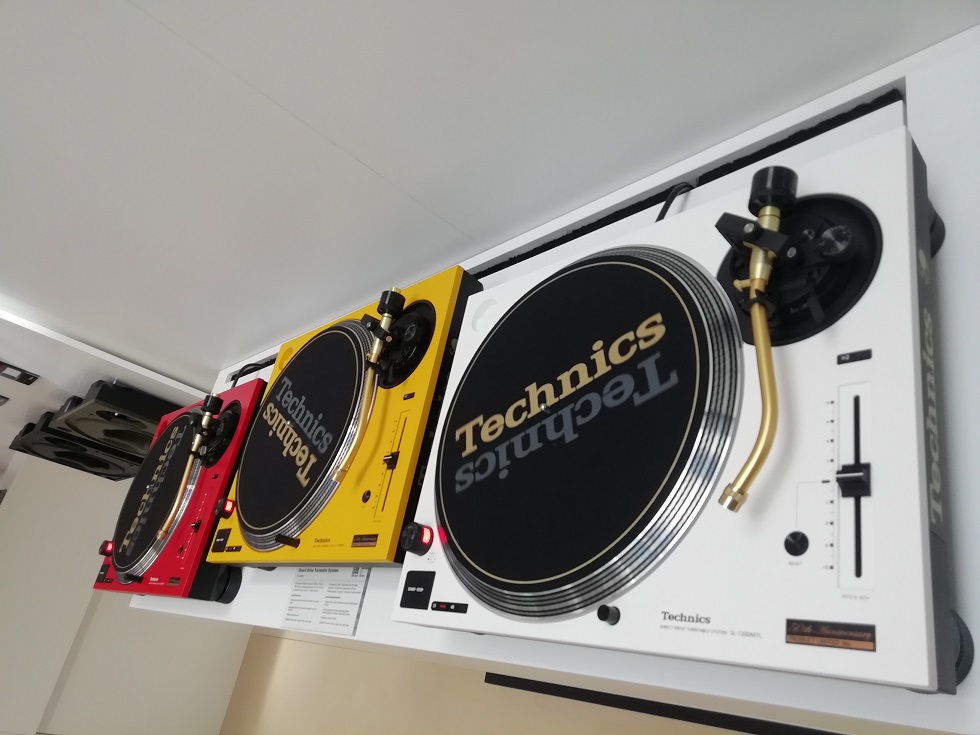
The active exhibition, instead, saw the usual double system:
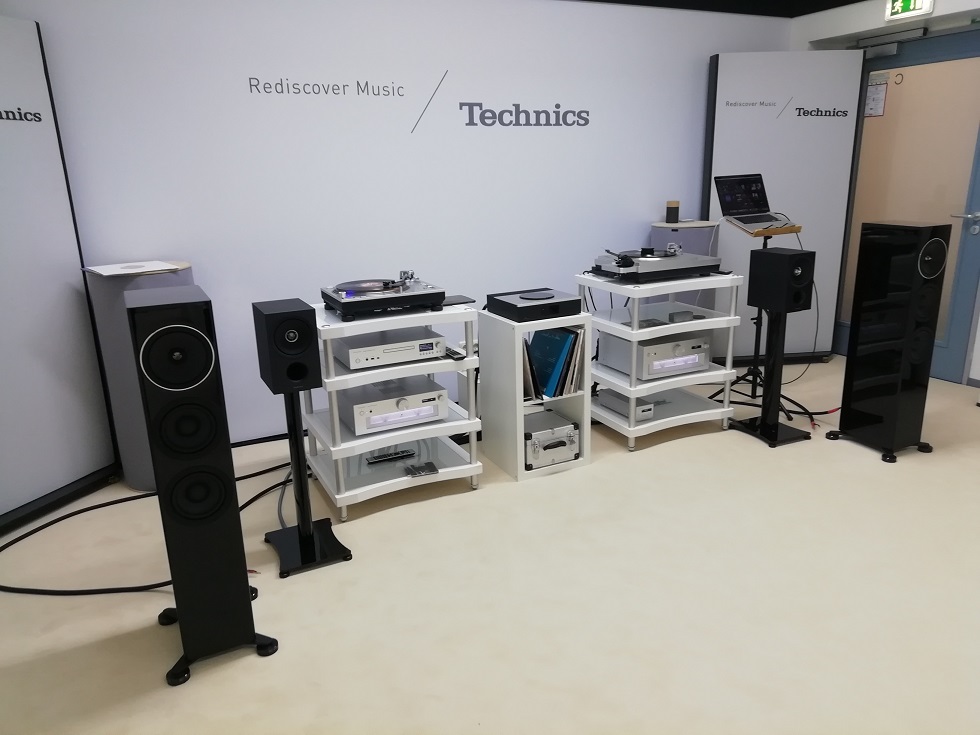
one for the Grand Class range, with a 1200 G (Eur 3.500), a SL-G 700 CD player/streamer (Eur 2.300), a SU-G 700 M 2 integrated amplifier (Eur 2.500) and the SB-C 600 bookshelf loudspeakers (Eur 1.000 for the pair);
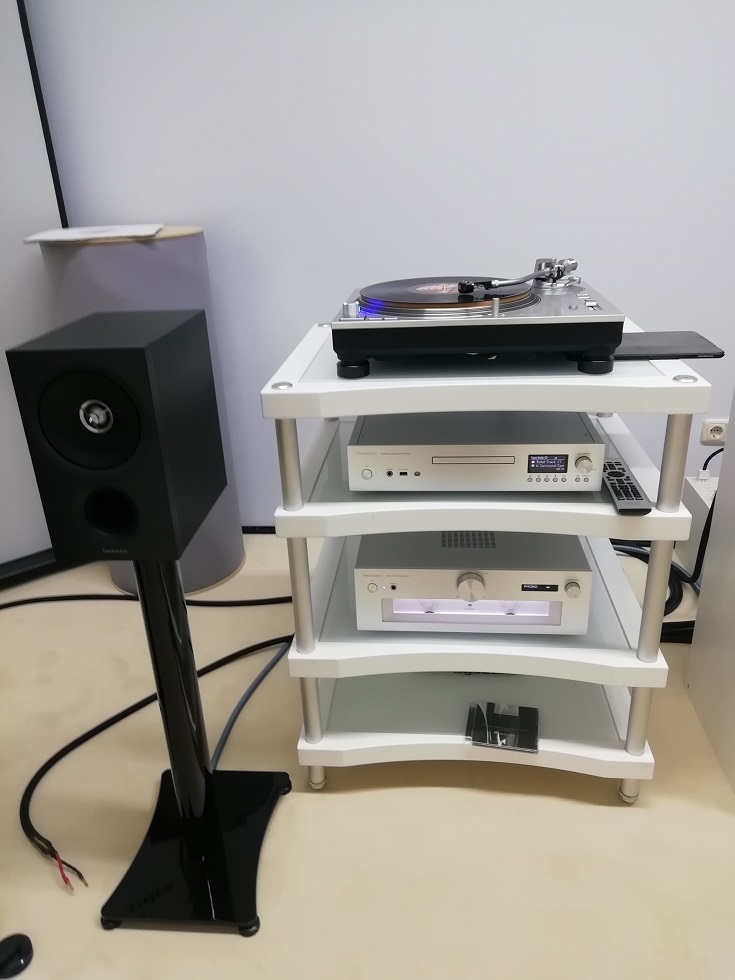
the other one for the Reference range, with a 1000 R (about Eur 8.000) with two mounted arms (one by SME), this year both connected and working.
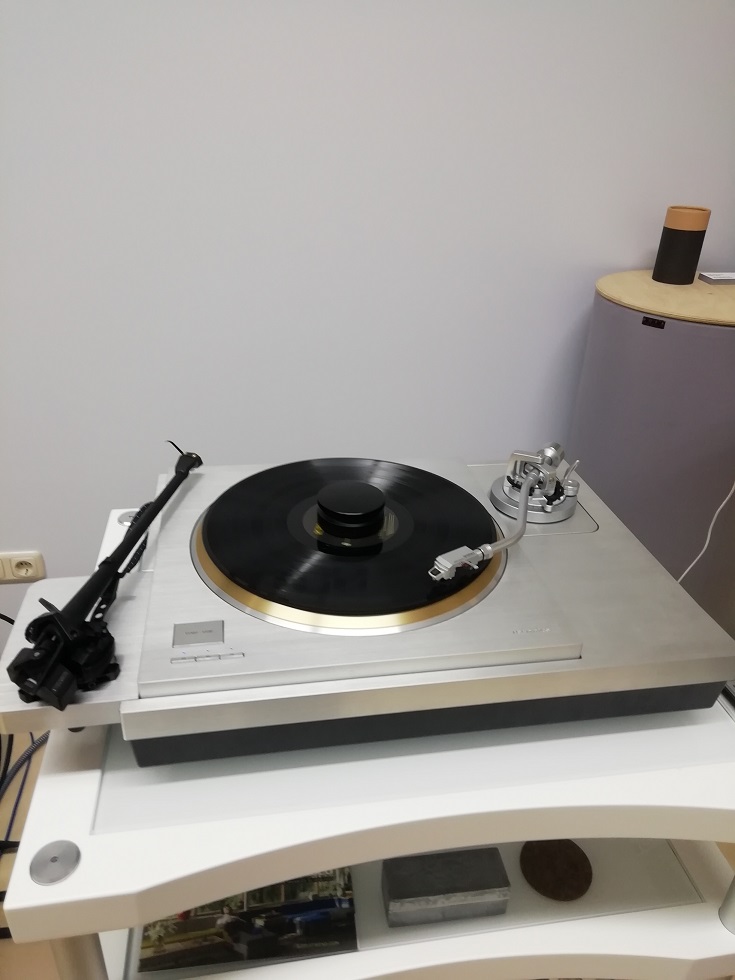
This turntable, too, was connected to an integrated amplifier, in this case the SU-R 1000 (about Eur 7.500),
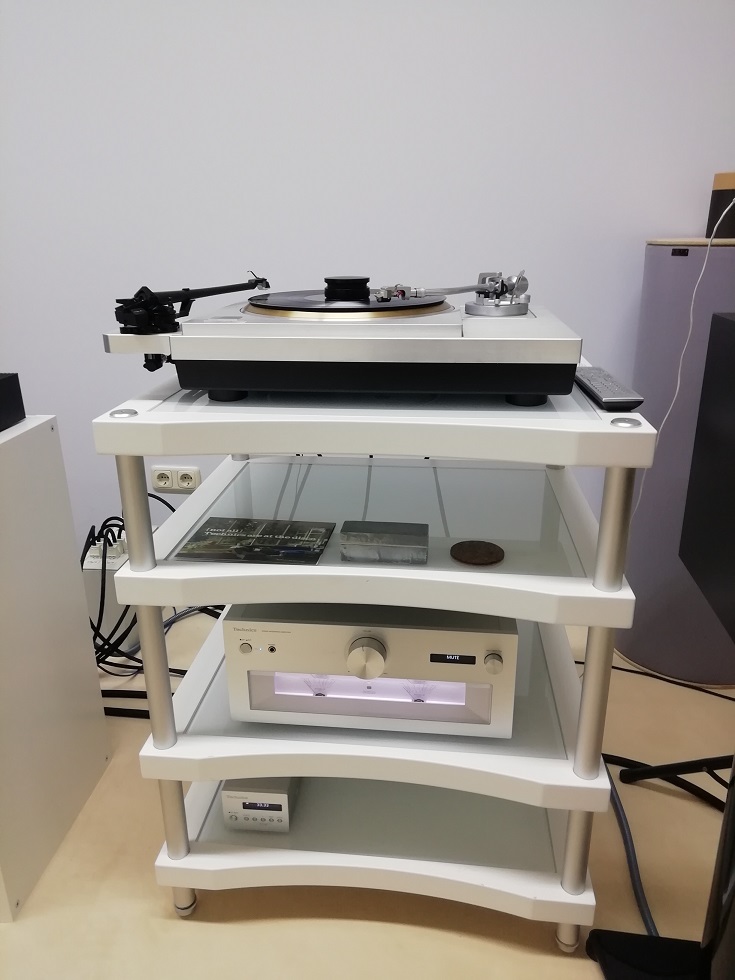
which, in turn, drove the SB- G 90 floorstanding loudspeakers (Eur 4.000 per pair): here you can see one of them, near its little sibling from the lesser system.
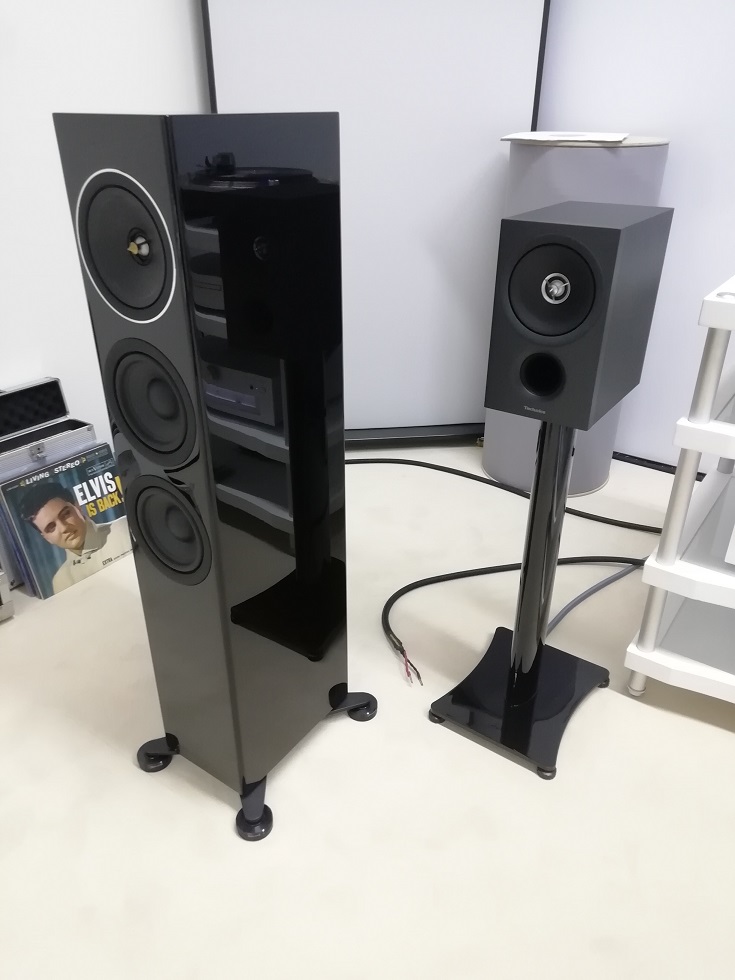
A good sound came from the room dedicated to the electronics by Doshi Audio, hosted by the very kind Mr.Doshi himself.
Source was a nice turntable by Kuzma, which was connected to gear from the Evolution range: the phono preamplifier (Eur 28.000) and the line premplifier (Eur 28.000),
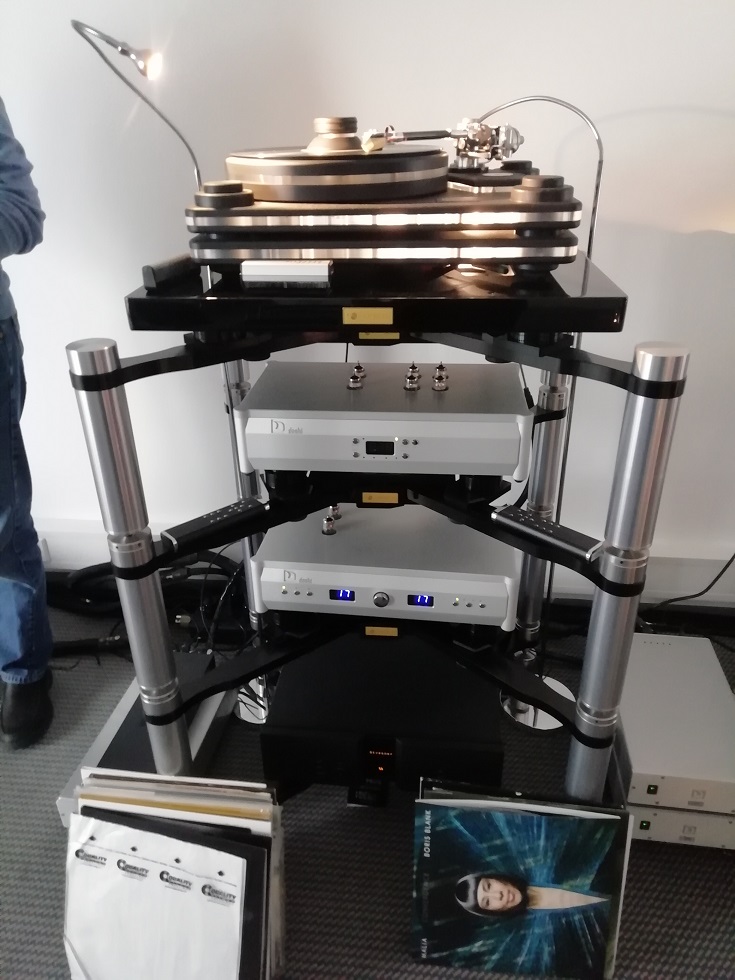
both powered by their own separate power supplies,
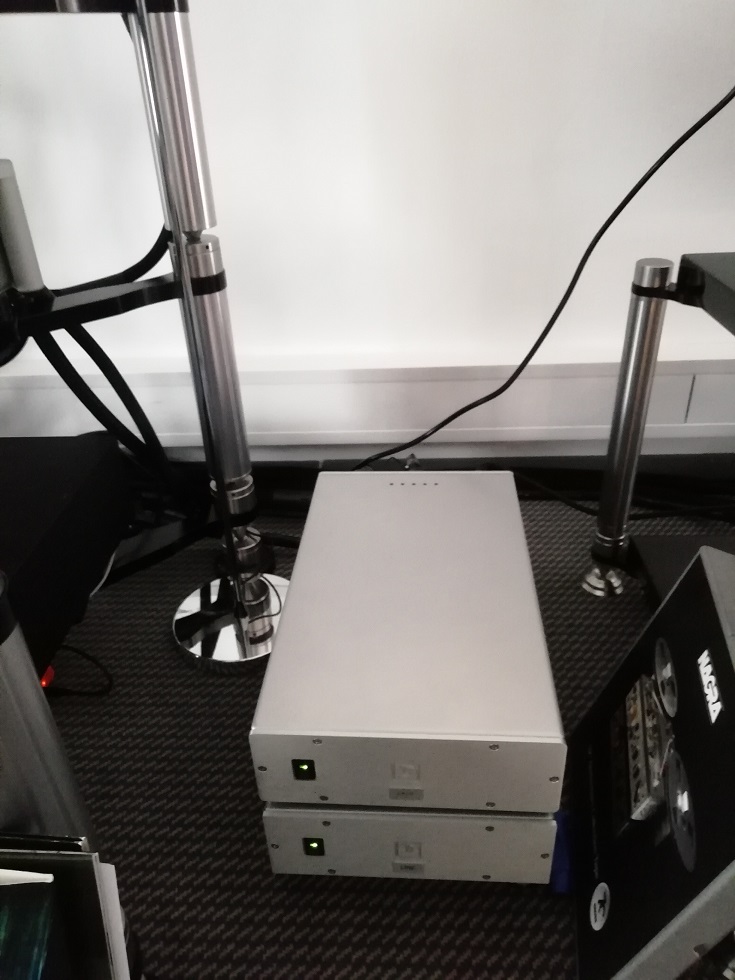
and, in turn, connected to two monoblocks (Eur 55.000).
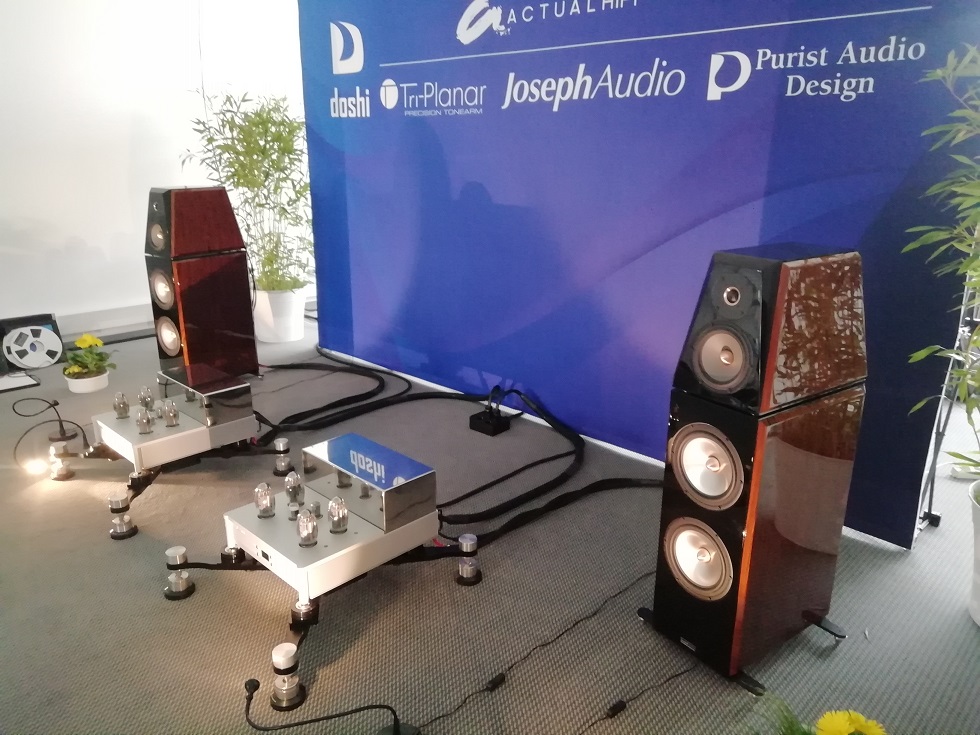
Doshi's gear is receiving much praise in the overseas press; yet, based on my previous experience, I am sure that the pleasure of the sound I heard there was also due to Joseph Audio's loudspeakers, in this case the Pearl Graphene model.
That same loudspeaker model, albeit with a different finish, gave voice to the system exhibited by Alluxity,
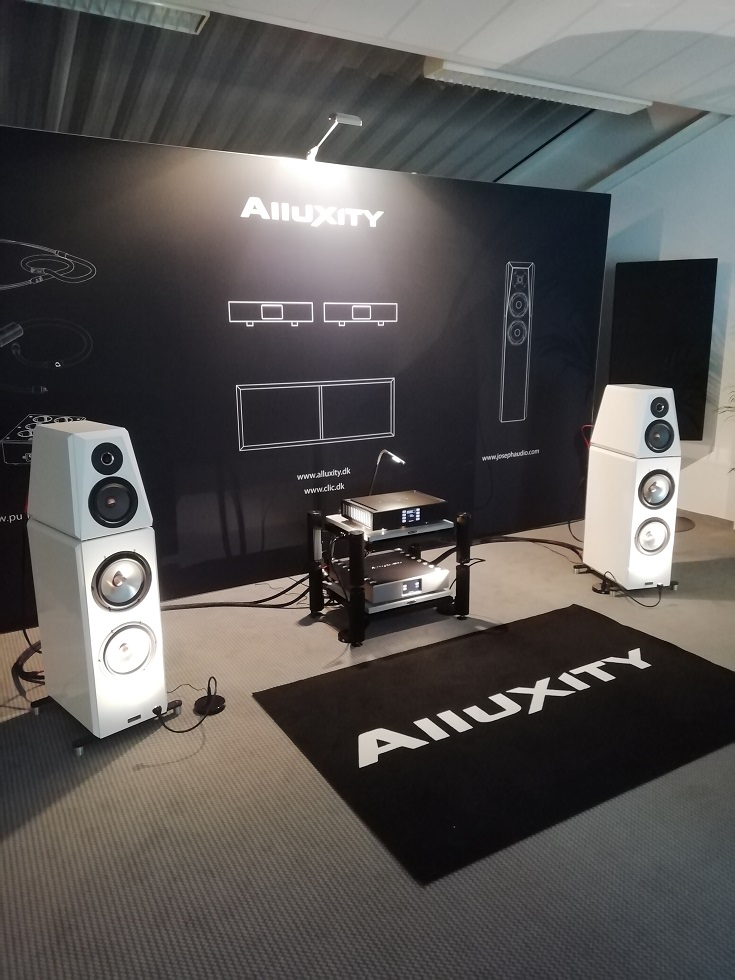
in particular, the Pre Two line preamplifier and the Power One power amplifier, each for about Eur 11.000.
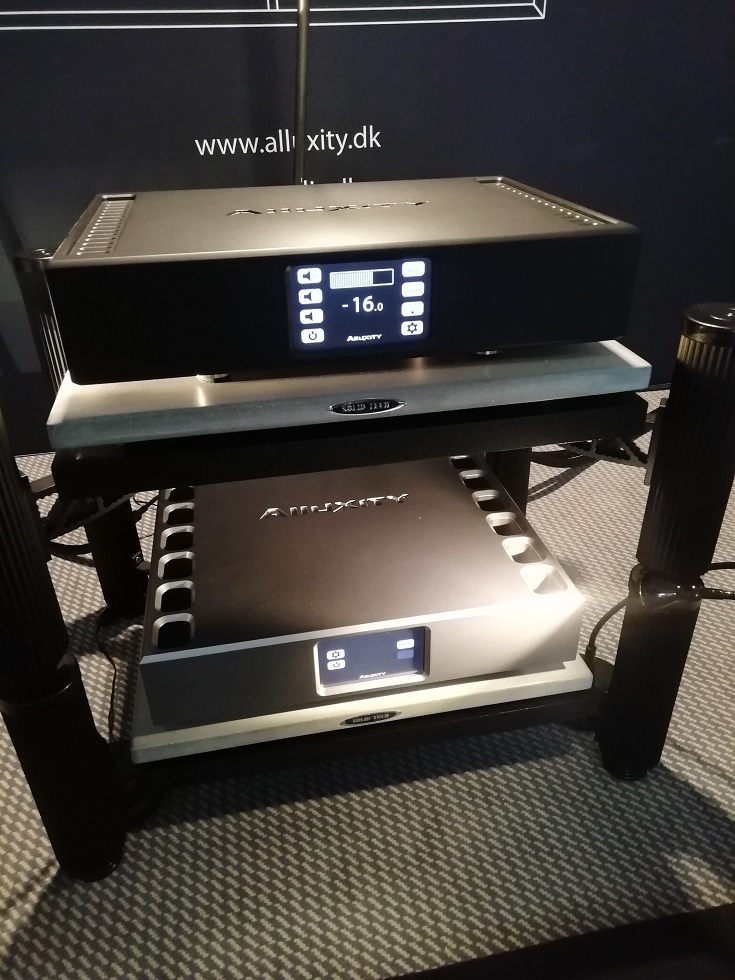
Another big exhibition was the one mounted by YG.
This loudspeaker maker had two approaches.
The first one was the Vantage Live, YG's way to put the system inside the loudspeaker. Actually, YG's solution is more "traditional", in that inside the loudspeaker you find the digital amplification modules (developed with Bel Canto) and the DSP for the crossover; the loudspeakers, then, are driven by an external controller, a box that contains, besides the processor and the streaming module, the connections for your LAN, digital and analogue inputs (one for phono, too). Everything for the friendly amount of about Eur 60.000, which is in line with the other prices attached to this company's products.
Here you have a mediocre picture I shot. Don't let the humongous monoblocks fool you: the loudspeakers were connected only to the mains (via the purple pytons you see on the floor, behind them).
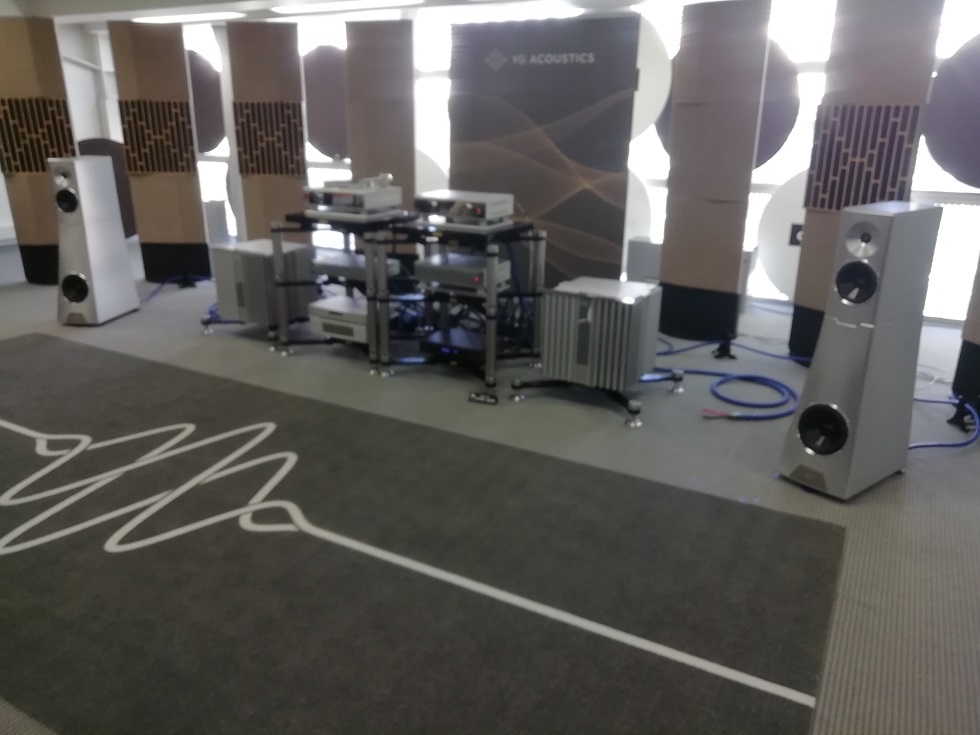
Of maybe higher interest is the new Peaks range, an attenpt to make loudspeakers less expensive than usual (I didn't write affordable...) by making the cabinet not with the aluminum traditionally used by YG, but with the more common wood, worked and shaped with high precision. Here you can see the Summit floorstanders, for about USD 25.000.
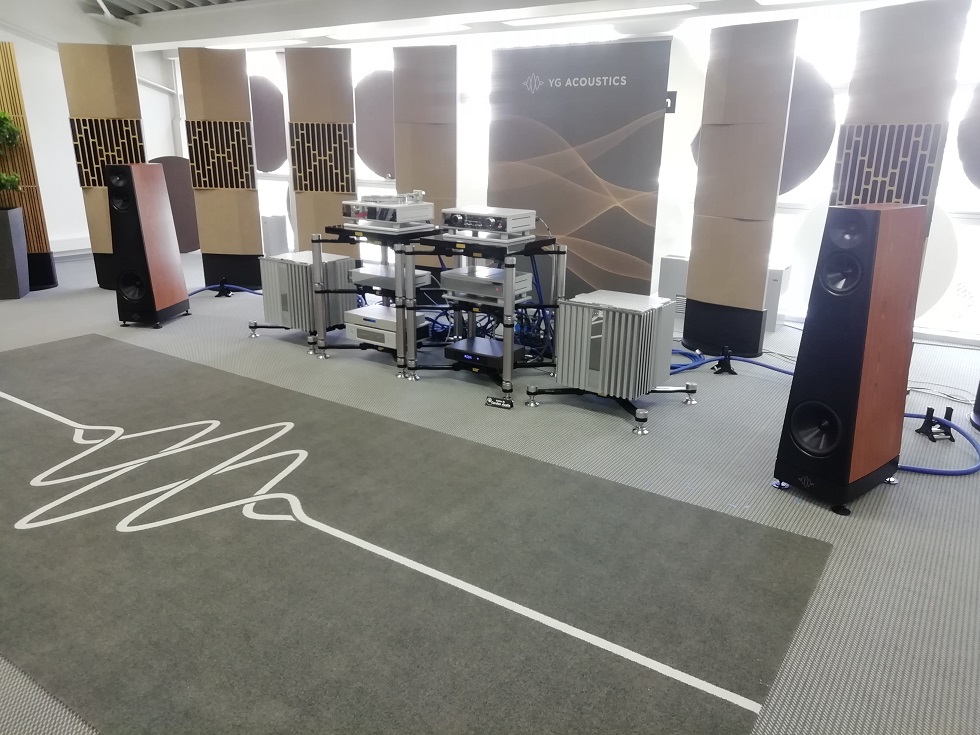
Its look recalls YG's typical tapered lines, but is more traditional and, for me, less "intimidating", seemingly easier to put into a normal domestic environment.

The shape of YG's Summit remined me the one of the loudspeakers by the Canadian Verity Audio - look at their Arindal model, premiered at the show, for a projected price of Eur 41.000.
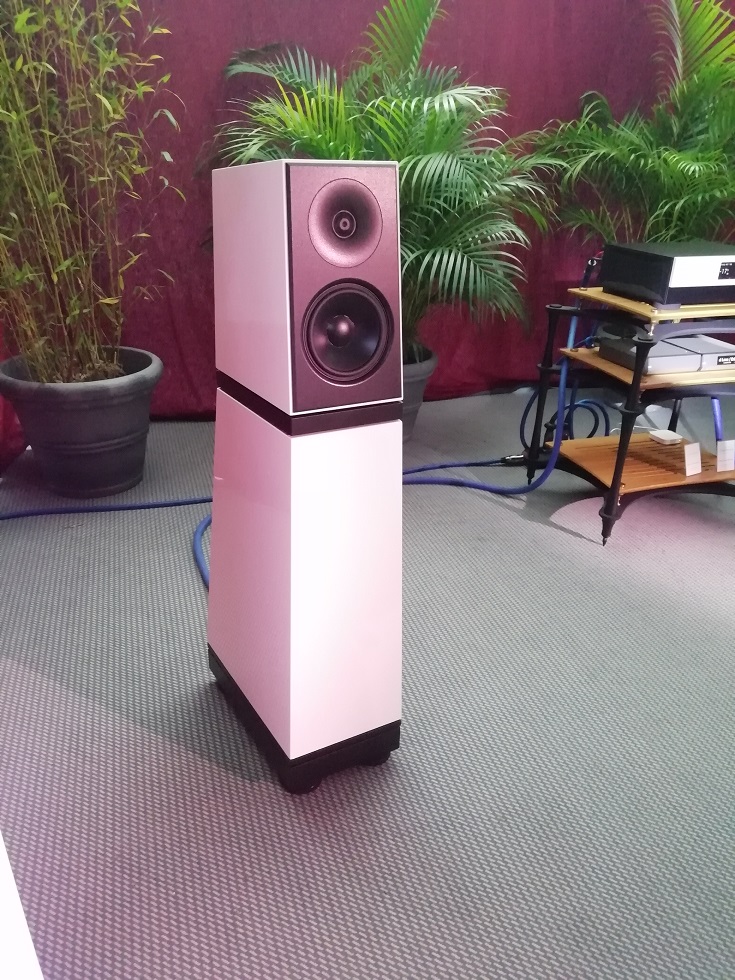
Verity's exhibition aimed to let people know also of their new INT-100, a stereo integrated amplifier capable of 100 W/ch (specificed at 8 Ohm). Its construction is modular: in its "basic" version it costs Eur 30.000; then you can add a totally configurable MM-MC phono module (adding Eur 4.000) and a DAC module, to decode PCM up to 192 kHz/24 bits (32 via USB) and DSD up to 512 (only via USB), for Eur 4.800 more.
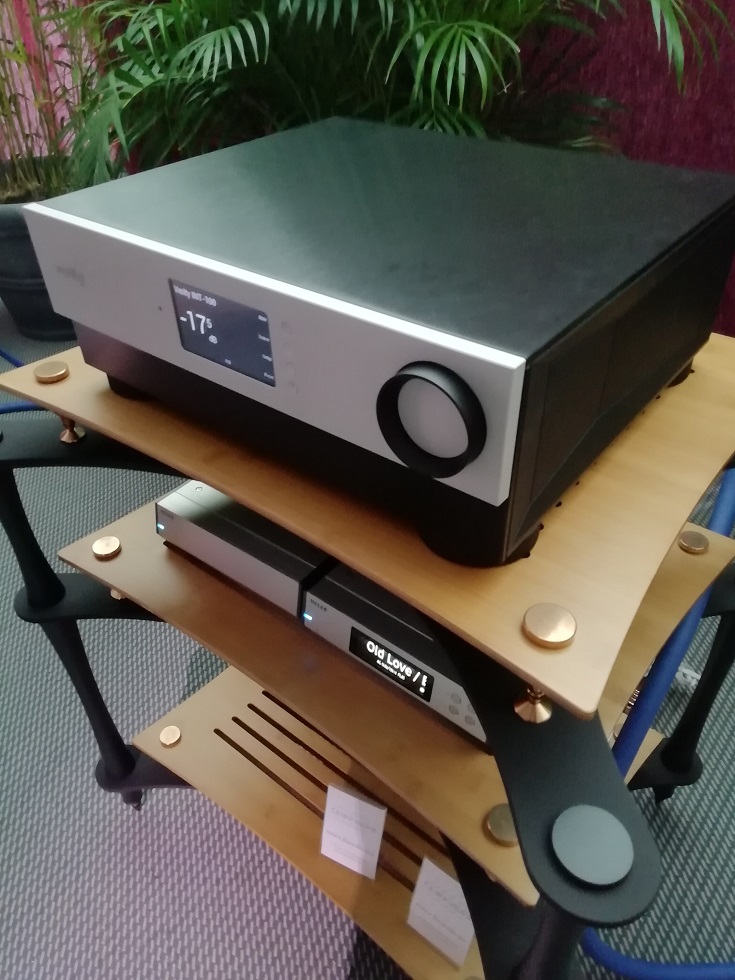
Another pleasant and varied exhibition was the one, dedicated to headphone listening, by Violectric and Lake People, occasionally united with other brands in the booth of their international distributor CMA Audio, who is available to help you in case of an absence of local dealers or ditributors.
Here we have an example of different configurations of an audio system to complete with the headphones of your choice.
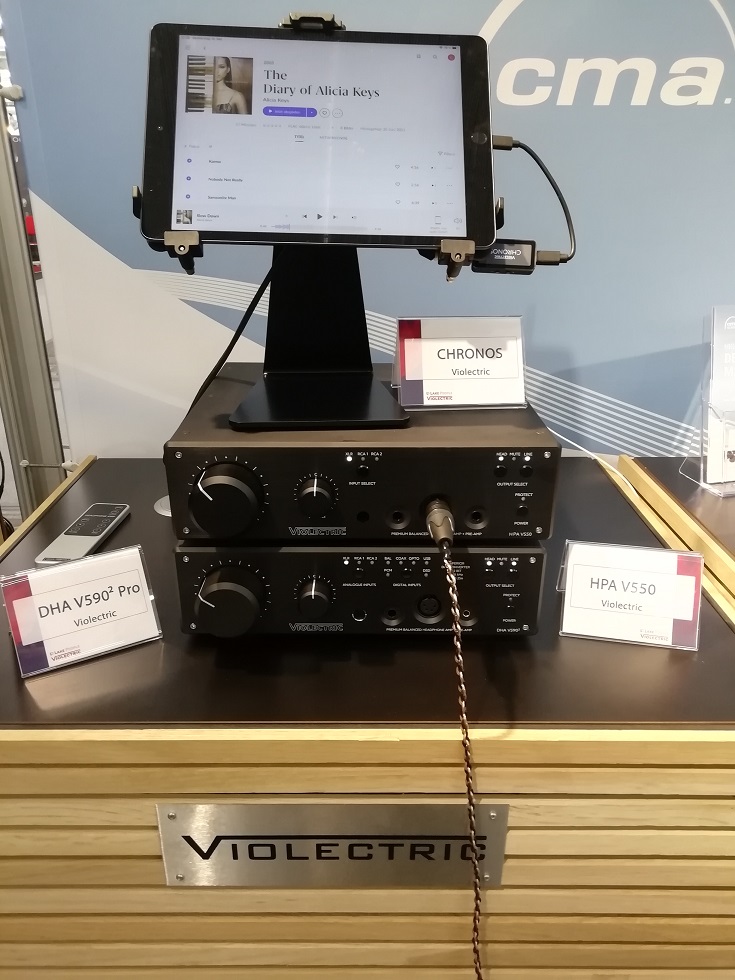
It is obviously controlled by the iPad, with which you have access to your music files, and the audio can be sent towards you headphones via a dedicated amplifier. The lower one is the V 590 2 PRO model; it can work also as a line preamplifier and as a DAC, and it costs between Eur 2.800 and Eur 3.300, depending on its configuration (for instance, you can choose the type of attenuator, even a stepped one). The one on top is the V 550 model, and has a cofiguration similar to the former, but without the internal DAC and costs about Eur 2.600.
Maybe more interesting is their dongle, named Chronos, that can decode also DSD 256 and sells for about Eur 200. They are developing a version with balanced outputs, the K-PRO.
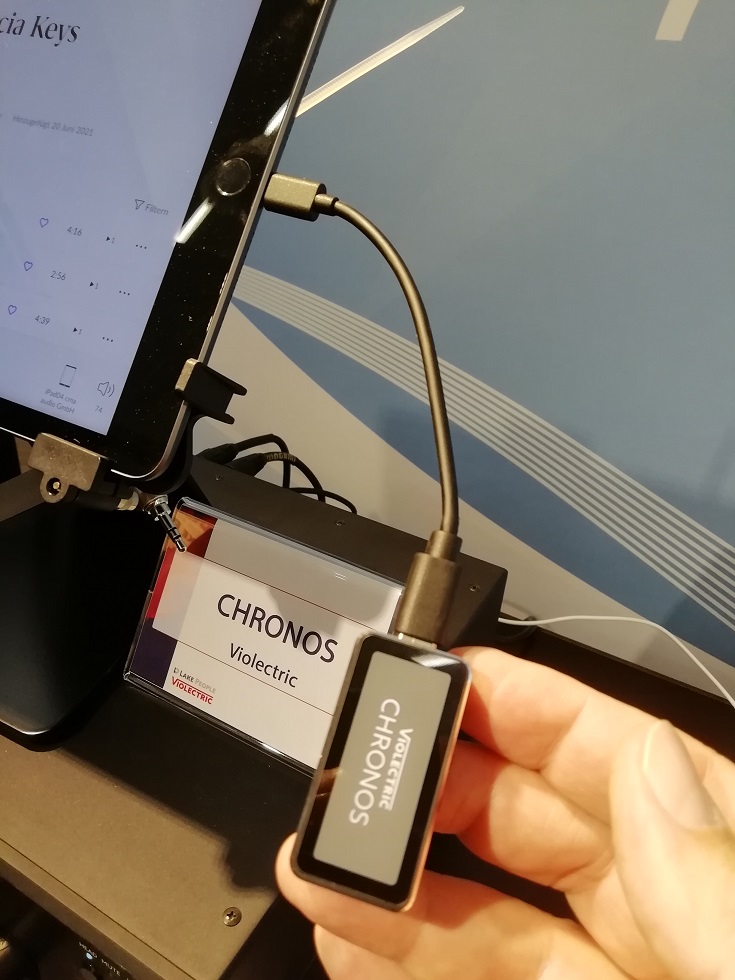
Besides the electronics, Violectric is working with the famous cable company Mogami, developing a cable range dedicated to the needs of headphone lisetening.
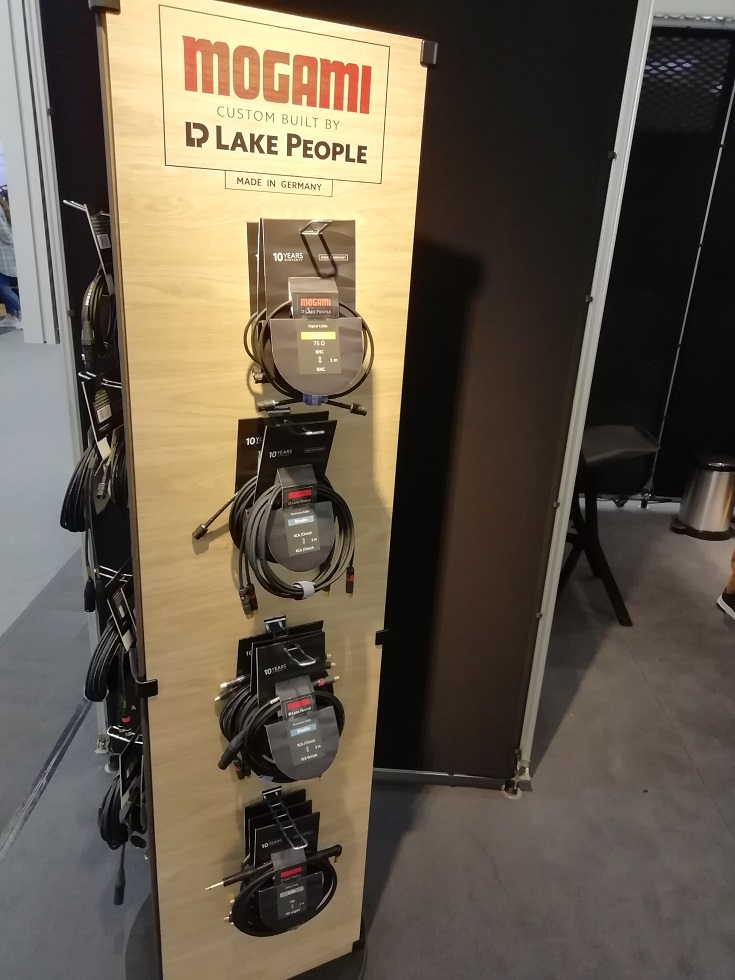
Finally (for now), a nice thing I saw at Innuos'.
This company is famous for their music servers and music file players, for which they developed interfaces and power supplies. This year, they exhibited the PULSE Network Players range. The top is the PULSAR, for Eur 5.500, with the best USB interface and power supply; then you go down to the PULSE, featuring only a high-performance power supply, for Eur 2.600. Then you land at the, for me, more interesting PULSE Mini,
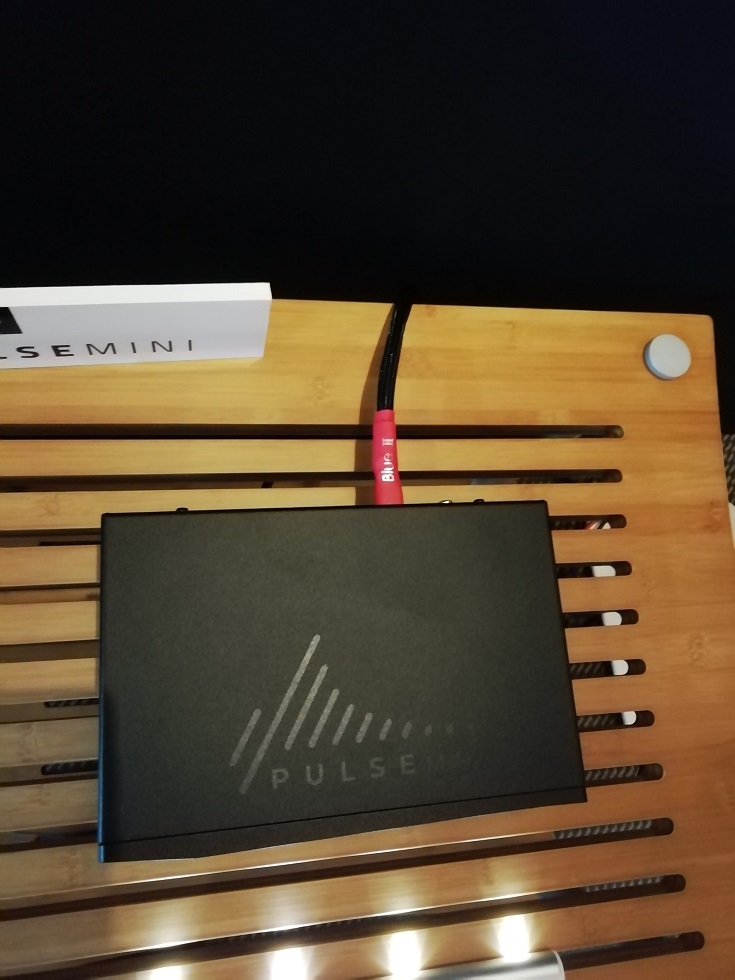
which, for Eur 1.000, features all the funcionalities you need, but wihout a special power supply. BUT in Innuos' catalogue you can find a MINI LPSU separate power supply, for Eur 600. So, you can taste Innuos' quality with just the MINI and then, if you like it, you can upgrade the power supply, spending a sum LOWER, albeit not much, than the "regular" Pulse. Maybe you won't get the same performance level of the Pulse's internal power supply, bit I suspect that differences are not that big...
Pit stop
Once again, I'm forced to stop here. But I'll probably be back with other pictures and tales ;-)
In the meanwhile, here is the link to the first part and to the second one. Fast forward to Part IV.
DISCLAIMER. TNT-Audio is a 100% independent magazine that neither accepts advertising from companies nor requires readers to register or pay for subscriptions. If you wish, you can support our independent reviews via a PayPal donation.
After publication of reviews, the authors do not retain samples other than on long-term loan for further evaluation or comparison with later-received gear.
Hence, all contents are written free of any “editorial” or “advertising” influence, and all reviews in this publication, positive or negative,
reflect the independent opinions of their respective authors. TNT-Audio will publish all manufacturer responses, subject to the reviewer's right to reply in turn.
![[Donate with Paypal!]](../gif/donate_now.gif)
![[Follow us on Facebook]](../jpg/fb_small.jpg)
© Copyright 2022 Carlo Iaccarino - www.tnt-audio.com
[ Home | Staff & Contacts | HiFi Playground | Listening tests | DIY & Tweakings | Music & Books ]













































![[Donate with Paypal!]](../gif/donate_now.gif)